- Yachts for Sale
- Sales Report 2024
- FAQ – Luxury Crewed Yacht Charters
- FAQ – Bareboat charters
- FAQ – Sell your Boat
- FAQ – Buying a Yacht
- How Much does it Cost to Charter a Luxury Yacht?
- All Blog Posts and News
- Yachting for beginners
- Indian Ocean
- Mediterranean
- Sales & New build
- Motor Yacht
- Event & News


Best Yachts for Transatlantic Crossing: Our Selection and Advice for 2023
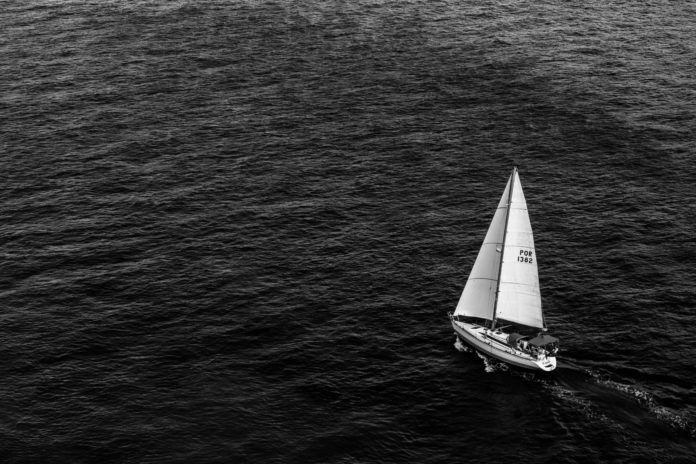
Sailing across the Atlantic is more than just an item on a bucket list for sailors. It’s how you get your boat to new horizons, whether to cruise the Caribbean islands or explore the waters around Europe. It’s a big undertaking and requires serious planning and a solid sailing vessel. You can cross the Atlantic by yourself, with a rally of like-minded racers and cruisers, or as part of a highly competitive race. But no matter how you go, the choice of a good sailing yacht lies at the foundation of a safe and enjoyable crossing.
What does a boat need for a transatlantic crossing?
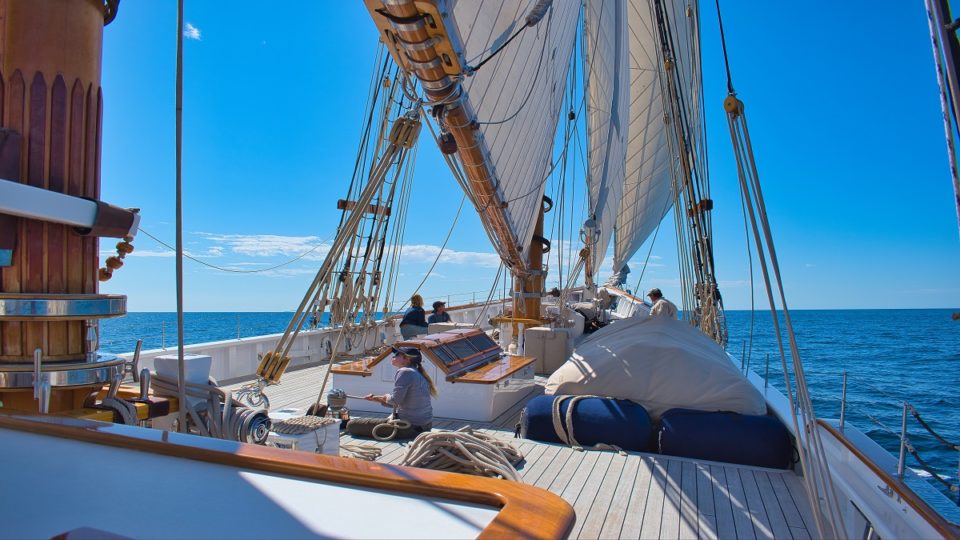
If you choose to do your transatlantic crossing with a rally or race, you’ll have to meet a stringent list of required equipment and safety checks. That’s easier because you have the lists right in front of you, and a team of inspectors to check your work. Preparing for a crossing with just one boat, the captain has to take all the responsibility and know what to check.
Sailing across the Atlantic is a serious undertaking, and you will sail out of range of shore-based rescue and into rapidly changing and possibly severe weather systems. You will have several thousand miles of nonstop sailing and may be at sea for several weeks.
What you must have
Any boat sailing across the Atlantic needs solid construction and a sound rig, a reliable auxiliary engine, and enough stores for food and water for the crew. That’s a bare minimum. Every boat needs to be checked from stem to stern to make sure systems are reliable, many older boats can certainly make this trip, and not every new boat is suitable.
Some tiny boats have crossed the Atlantic, so minimum size isn’t a requirement. What successful boats have in common is a solid hull and rig, with reliable sails and systems.
Most transatlantic yachts have a lot more
You can cross the oceans with a lightly equipped boat with few conveniences or extra safety gear, but most do not. A few things to look for on your boat include:
- An EPIRB satellite rescue beacon .
- Long range communication devices, such as satellite phones and single sideband radios.
- Certified life raft with space for all crew on board.
- Storm sails
- Storm safety gear such as drogues or sea anchors.
- Access to up-to-date weather forecasts and reports.
Do not head offshore without these
The list of required equipment for races and rallies is exhaustive, and many of the requirements are exacting and expensive. No one is enforcing compliance when you sail on your own. But there are a few things you should not head offshore without.
- A reliable auxiliary engine. If the wind dies and you need to dodge bad weather, this can be a lifesaver.
- Access to good, current weather information.
- Reliable sails. Have all sails inspected by a sailmaker for wear and damage before setting out.
- A life raft. If you run into serious problems and lose your boat, this is your last hope for rescue.
- Spare parts and tools for common repairs.
Read also: 10 Sailing Myths And Bad Advice You Shouldn’t Listen To
What experience do you need to do a transatlantic?
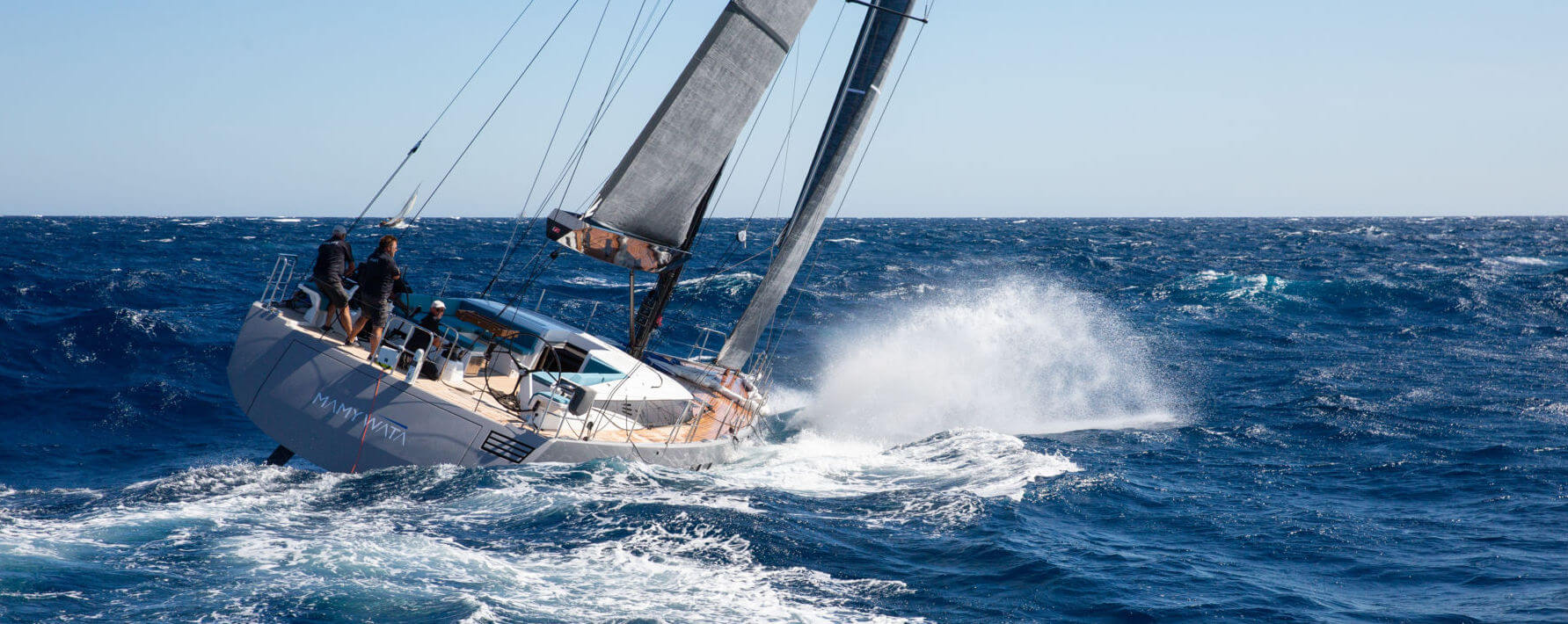
A transatlantic crossing is a major sailing milestone for experienced sailors. The north Atlantic is no place for new sailors and beginners, unless they’re with competent and experienced crew or a qualified captain.
If you’re thinking of a transatlantic crossing on your own, you’ll need experience with multi-day, nonstop passages. Sailing offshore is twenty-four hours a day and nonstop, there’s no place to park. Experience with night sailing, standing watches, navigation, provisioning, and basic engine and system troubleshooting are all a must.
Read also: Five Easy Beginners-Friendly Sailing Trips And Destinations
Chartering a yacht – a great option for less experienced sailors.
Charter fleets make seasonal moves from Europe to the Caribbean are an excellent way to get offshore sailing experience. Charter companies provide a captain and first mate, but you can reserve a spot and fill the roles of a full crew member, standing watch and sailing far offshore.
Many boats are also available for charter in cruising rallies, races, and deliveries. You’ll need to hire a captain with the needed offshore experience, but you may come away with enough experience to skipper your own yacht the next time.
The best yachts for a transatlantic crossing
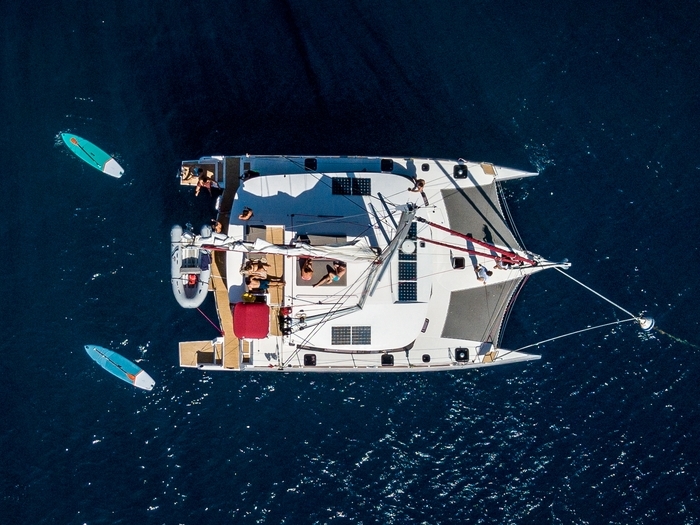
There are many yachts which are suitable for a transatlantic passage. Some will be less expensive, some will be more comfortable, faster, or better suited to you, your experience, and your budget.
NEEL 51: Fast and easy to sail trimaran
The NEEL 51 is a fast, comfortable trimaran suited to a smaller crew. It’s spacious, but easy to handle while putting up double digit speeds and 200+ mile days. Trimarans can be a little more sea-kindly in waves and chop than catamarans, and don’t heel hard like monohulls. A protected helm station gives great protection offshore and good visibility, and there space on board for plenty of crew and guests.
The racing version of the NEEL 51 is built with lighter materials, and features a larger rig to project more sail area for more speed, while still affording the same luxury and comfort at anchor.
More info about our Neel 51 available for charter
Outremer 5X: High-speed catamaran sailing
The Outremer 5X offers top tier performance and comfort in a single passage. Sustaining double digit speeds with east, the Outremer 5X is one of the fastest cruising catamarans on the market. Outremer is known for both performance and quality, and your transatlantic trip will be fast and safe.
With four different helm stations, she’s a sailing boat foremost. It’s designed for a small crew, even when tearing up the ocean on a fast passage. With options for three or four cabins and a cockpit that can fit a dozen people, she’ll be as comfortable when you arrive as she is fast on passage.
Hallberg-Rassy 57: Sturdy monohull with elegance and speed
Hallberg-Rassy builds tough cruising yachts, and the 57 is no exception. While monohulls don’t put up the blistering speeds you’ll find in multihulls, the Hallberg-Rassy 57 is no slouch and can log 200 mile days. Most offshore sailing and cruising is done in monohulls, and blue water sailors love their stability and seakindliness across all conditions.
The Hallberg-Rassy 57 has generous accommodations, and loads of capacity for gear supplies. The deck layout is clear, and lines and controls are laid out for easy use with a small crew. With a performance design by German Frers, the 57 sails well on all points of sail.
There are many choices for the best boat for you for a transatlantic crossing. No matter which boat you choose for your transatlantic and how you go – on your own, or on a charter – preparation is key. Your boat needs to be equipped with a full range of safety gear, and checked from top to bottom so you know your sails, hull, and engines will get you where you’re going.
Read also: The Caribbean To Mediterranean Sailing Routes: How To Cross The Atlantic Eastward
RELATED ARTICLES MORE FROM AUTHOR
6 great motoryachts just under 100 feet to consider, how to winterize your boat, sail the mediterranean onboard the custom line navetta 28 “yvonne”.
- Testimonials
- Privacy Policy
- THE PRINCESS PASSPORT
- Email Newsletter
- Yacht Walkthroughs
- Destinations
- Electronics
- Boating Safety
- Ultimate Boating Giveaway

Top 15 Trawlers for 2023
- By Patrick Sciacca
- October 13, 2023
For every shoe, there’s a foot, and for every boating enthusiast, there’s a yacht. For those individuals who like to cruise their yachts across blue water, spend months on board or voyage to remote beaches and quiet coves, a trawler yacht is the go-to vessel choice. But even within this yacht genre, there are many options. For example, there are some mighty midsize trawlers that are easily capable of transatlantic crossings for an adventurous couple, and then there are megayacht-size craft with next-level amenities that require extra crew. Some trawler-yacht builders offer significant customization and others work from a fixed options list. There are single-engine trawlers and twin-engine trawlers. One thing that is common is that these trawler yachts are designed from the ground up for yachtsmen with wanderlust in their hearts.
Top Trawlers
The following 15 trawlers are all vessels we’ve written about. They are listed in no particular order.
- Nordhavn 96 : Built for an owner who desired to self-sufficiently while cruising the world, literally.
- Beneteau Grand Trawler 62 : This trawler can travel nonstop for 1,000 nautical miles.
- Kadey-Krogen 52 : This twin-engine-capable, all-oceans trawler is a solid fit for voyaging cruising couples.
- Bering Yachts B76 : The B76 is the builder’s first fully custom trawler in this size range.
- Ranger Tugs R-43 Command Bridge : This vessel is equally comfortable at a 7-knot stroll or an 18-knot jog.
- Beneteau 48 Swift Trawler : Based on the builder’s Swift Trawler 47, this yacht has a resin-infused fiberglass hull.
- Kadey-Krogen 50 Open : The 50 Open can cruise at 6 knots nonstop for 5,000 nautical miles.
- Outer Reef 620 Trident : It has a three-stateroom layout and optional 600 hp Cummins diesels.
- Grand Banks 60 Skylounge : This yacht is efficient across a variety of cruising speeds.
- Krogen Express 52 : Headroom to spare, two staterooms, a chef-ready galley and long range define this trawler yacht.
- Grand Banks 85 Skylounge : Grand Banks’ V-warp hull form makes for a level running attitude, seakindliness and long range.
- Vicem Yachts 82 Classic : Construction is in cold-molded, strip-planked mahogany with epoxy.
- Outer Reef 610 Motoryacht : Power on this Outer Reef is a pair of 500 hp John Deere 6090 diesels.
- Nordhavn 59 Coastal Pilot : Did someone say this is a 20-knot Nordhavn?
- Marlow 58E : A high level of customization and admirable performance are at the heart of the Marlow 58E.
Nordhavn 96
The Nordhavn 96 is the yacht builder’s second-largest yacht its 17-model fleet, which ranges from 41 to 120 feet length overall. (There is a new 112 on the drawing table.) The builder says the N96 is based on its earlier 86-footer with a 10-foot cockpit extension, which increases both main-deck, skylounge and below-deck volume. The N96 we reviewed was built by an owner who previously had an 86-foot Nordhavn, but with his plans for extended cruises to remote destinations, the 96 was the right size for his voyaging plans. In fact, since the owner took delivery of the boat, it has been on a continuous circumnavigation.
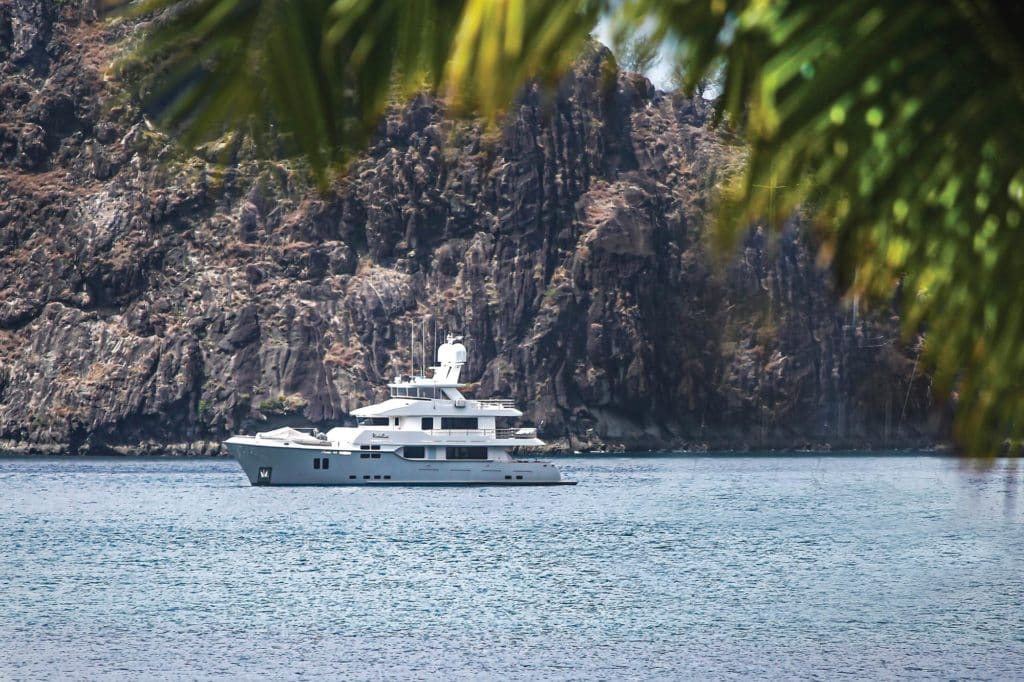
Quick Specifications
| 96’7” | |
| 24’0” | |
| 7,000 Gal. | |
| 900 Gal. | |
| 8’2” | |
| 400,000 lb. |
Beneteau Grand Trawler 62
Beneteau’s Grand Trawler 62 has 1,000-plus-mile range and 20-knot speed with twin 730 hp i6 MAN diesels . The Grand Trawler 62 is the builder’s flagship in its Trawler series, which also includes the Swift Trawler 35 , Swift Trawler 41 Sedan , Swift Trawler 41 Fly and Swift Trawler 48 . Small touches set the Beneteau Grand Trawler 62 apart. They include sea rails on all lockers to keep stowed food and gear in place, leather-wrapped interior handrails for security in a seaway, and leather drawer pulls like those found on larger yachts. Long-range cruising accommodations include a full-beam master stateroom aft, a forepeak VIP and twin-berth guest stateroom. A Quick X3 gyrostabilizer helps mitigate any potential rocking and rolling on rough days.
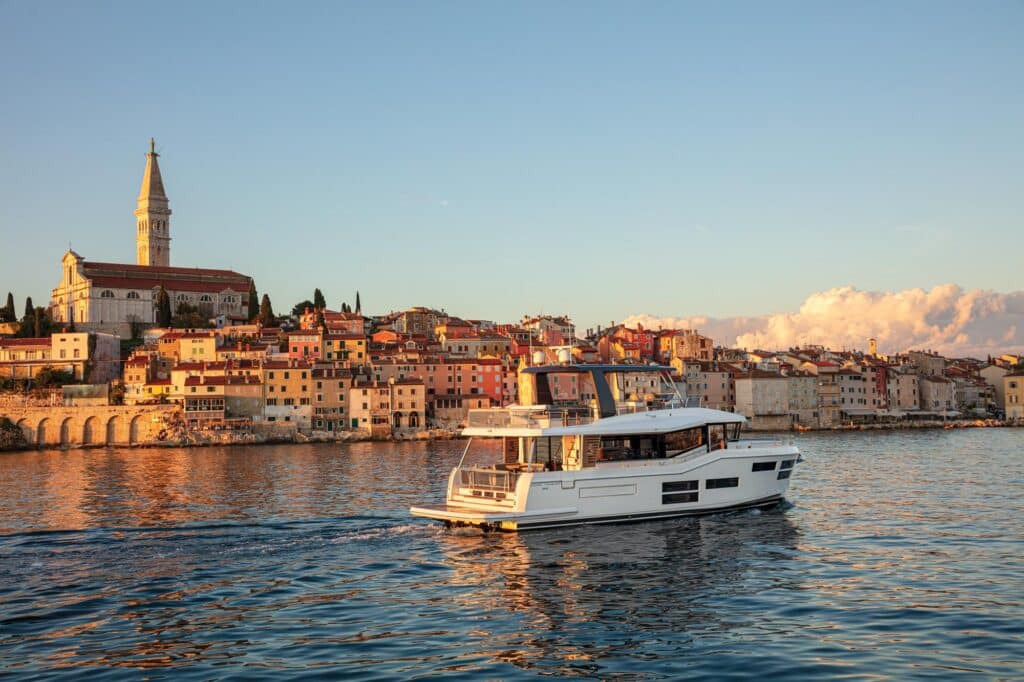
| 62’2” | |
| 17’10” | |
| 1,022 Gal. | |
| 222 Gal. | |
| 4’7” | |
| 61,729 lb. |
Kadey-Krogen 52
The Kadey-Krogen 52 is the trawler-yacht builder’s smallest offering in its raised-pilothouse series, complete with a Portuguese Bridge. Owners can choose from either a two- or three-stateroom layout, and between a single-diesel engine or twin-diesel engines, for owners seeking redundancy. The standard engine is a 231 hp John Deere diesel. With the single-engine setup, draft is 5’5” and with twins it’s a shallower 4’6”. At 6 knots, range is an ocean-crossing 4,850 nautical miles. At 7 knots, it’s 3,300 nm. At 9 knots, it 1,700 nm. The builder states, “The entire Krogen 52 is built from only three molded pieces for maximized structural integrity. There are no additional secondary bonds or caulk joints that can inevitably cause issues. All deck and superstructures are cored and vacuum-bagged to maximize strength while minimizing weight.” Additionally, six longitudinal stringers enhance overall strength.
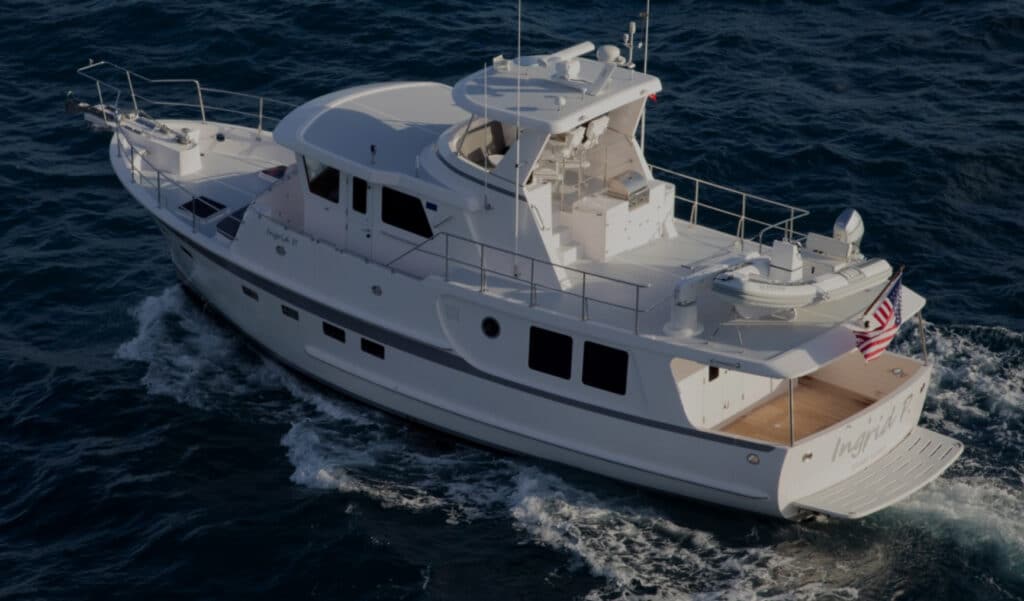
| 57’9” | |
| 17’9” | |
| 1,400 Gal. | |
| 400 Gal. | |
| 5’5” (single) 4’6” (twins) | |
| 70,000 lb. |
Bering Yachts B76
Lemanja is the first custom boat that Bering has built in this size range. The yacht is notable for its steel hull and aluminum superstructure, and for its 4,000-nautical-mile-plus range with its twin 404 hp Cummins QSL9 diesel engines. As rugged as the Bering 76 is built on the outside, it also offers homelike comforts in its skylounge inside, offering panoramic views out large windows surrounding the space. Sole-to-ceiling glass offers similar views in the open-plan salon. Accommodations are fox six guests in three staterooms with a master stateroom and two guest staterooms, plus crew accommodations. In addition to its traditional diesel engines, the B76 has a solar-rechargeable battery bank for hybrid propulsion.
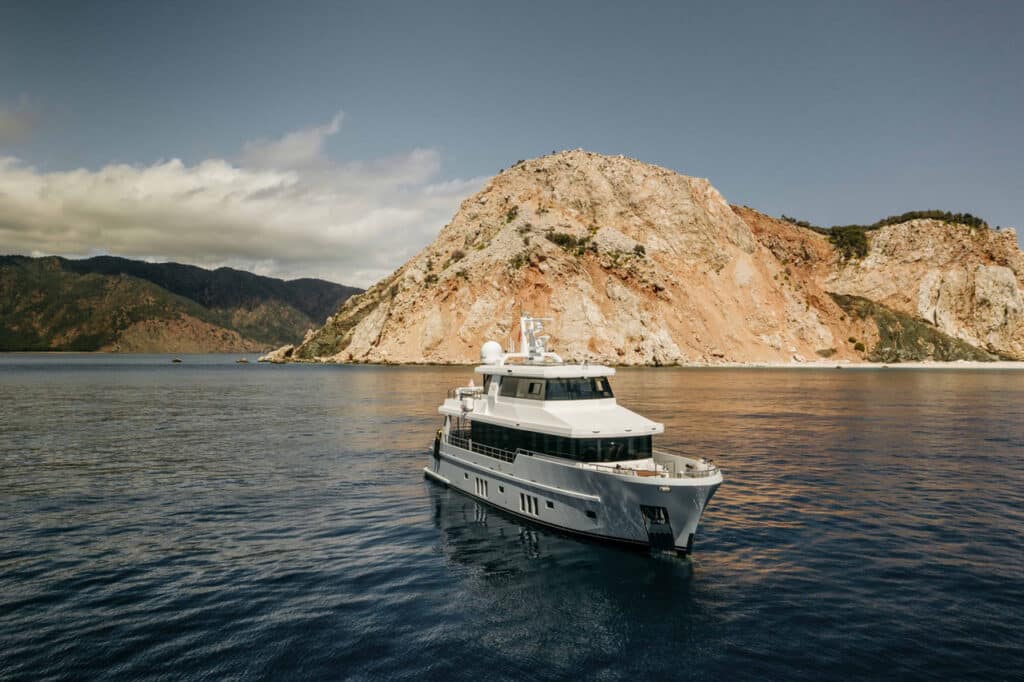
| 73’3” | |
| 19’3” | |
| 6,750 Gal. | |
| 946 Gal. | |
| 6’5” | |
| 287,000 lb. |
Ranger Tugs R-43 Command Bridge
The Ranger Tugs R-43 Command Bridge is a long-distance cruiser with creature comforts. Our expert found the R-43 Command Bridge to be a solid candidate to cruise The Great Loop . We agree. Twin Volvo Penta IPS450 pod drives give the boat efficient low and high cruise speeds at 7 and 18 knots, respectively. For those that have work during their cruise, the R-43 Command bridge’s master stateroom is set up with an office with a desk. Long trips require extra stowage and a way to clean salty clothes, so on the R-43 Command Bridge there is a washer, dryer, auxiliary refrigerator/freezer and stowage under the dinette, which rises on electric rams. Voyagers who buy a R-43 Commander Bridge can opt for a Factory Delivery Experience, which is three days of instruction on Puget Sound, and includes in boat systems, handling and maintenance.
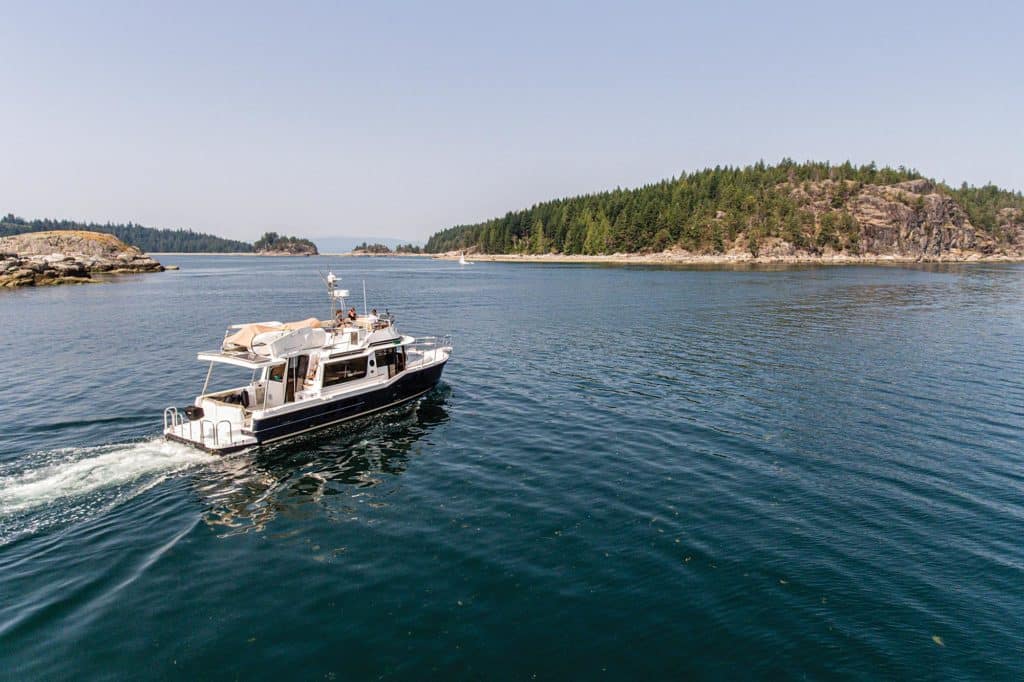
| 46’9” | |
| 14’ | |
| 300 Gal. | |
| 120 Gal. | |
| 3’6” | |
| 2/Volvo Penta IPS450s |
Beneteau Swift Trawler 48
The Beneteau Swift Trawler 48 has a 1,300-nautical-mile range at 8 knots, but can also speed away at 26 knots if the weather goes south in a hurry. Based on the builder’s 47-footer , the three-stateroom, two-head Swift Trawler 48 has a resin-infused fiberglass hull. Power is a pair of 425 hp Cummins diesels. The main-deck layout includes a galley aft setup, which is accessible to the cockpit. There, the seating and dining area can be fully enclosed, with tracks in place for side curtains. The helmsman is kept comfortable on long passages with a bolstered, pedestal bucket-style seat with a flip-up footrest. The Swift Trawler 48 we reviewed had upgraded 12-inch Raymarine HybridTouch displays (9-inch screens are standard).
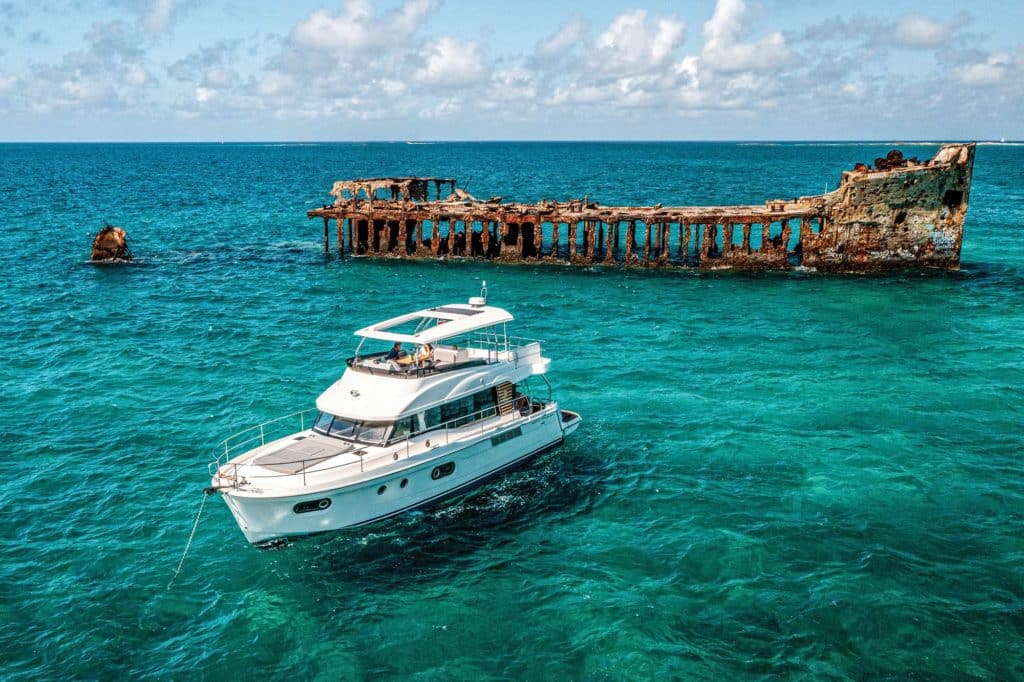
| 48’4” | |
| 14’9” | |
| 510 Gal. | |
| 169 Gal. | |
| 3’10” | |
| : | 27,896 lb. |
Kadey-Krogen 50 Open
Designed for serious extended cruising, Kadey-Krogen Yachts 50 Open provides owners with amenities that will enhance those longer passages. The galley is fitted with a Sub-Zero refrigerator and freezer, a four-burner Wolf range, a microwave and an optional dishwasher. Unlike in many trawlers and their traditional pilothouse design, the galley is located on the same level as the helm and salon. Belowdecks is the master stateroom amidships with two hanging lockers, 12 cabinets, additional drawers for stowage and an en suite head, shower and two sinks. Forward of the master is an office. The 50 Open’s hull has soft chines and a curved after end, much like the characteristics of a sailboat built for cruising. The result is an efficient hull form that provides a gentle landing into troughs when the sea gets a temper. This trawler can cruise at 6 knots for 5,000 nautical miles; 7 knots for 3,000 nautical miles; 8 knots for 2,100 nautical miles; and 9 knots for 1,200 nautical miles.
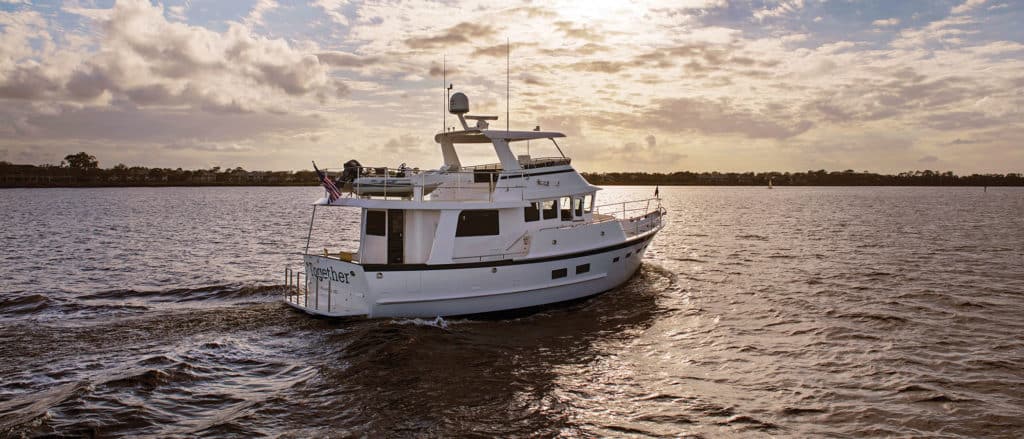
| 52’9” | |
| 17’5” | |
| 1,240 Gal. | |
| 400 Gal. | |
| 5’4” | |
| 68,000 lb. |
Outer Reef 620 Trident
Outer Reef Yachts 620 Trident delivers a three-stateroom layout and optional 600 hp Cummins diesels that allow this vessel to approach a top hop of 21 knots. Cruising speed is a little over 16 knots, burning about 34 gallons of fuel per hour at 2,750 rpm. The amidships master stateroom has 6-foot-8-inch headroom, a walk-in closet and a shower enclosed in smoked glass. In the forepeak VIP stateroom, there are seven drawers, a hanging locker, a 31-inch Samsung TV and 7-foot headroom. The portside guest stateroom can convert to an office, too. The aft galley has a U-shape countertop, a three-burner electric cooktop, a Bosch microwave and a Vitrifrigo refrigerator and freezer. Cherry, walnut and oak are the available wood options.
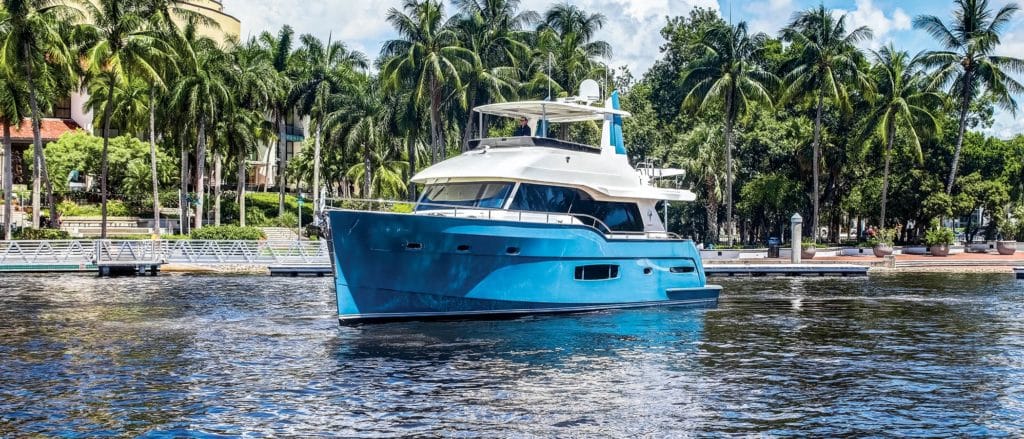
| 61’8” | |
| 16’2” | |
| 800 Gal. | |
| 185 Gal. | |
| : | 4’0” |
| : | 51,000 lb. |
Grand Banks 60 Skylounge
It’s obvious after a quick peek inside the Grand Banks 60 Skylounge that the Grand Banks Yachts trademark external DNA is retained. The deck, cabin house and skylounge are all composed of infused carbon fiber, reducing weight aloft and creating a lower center of gravity. With twin 900 hp Volvo Penta D13 diesels , the 60 Skylounge can accelerate to 31 knots and cruise at about 25 knots. The 60 Skylounge can also travel up to 2,000 nautical miles at 10 knots on a 1,530-gallon fuel tank. Twin 1,000 hp Volvo Penta IPS1200s are also available.
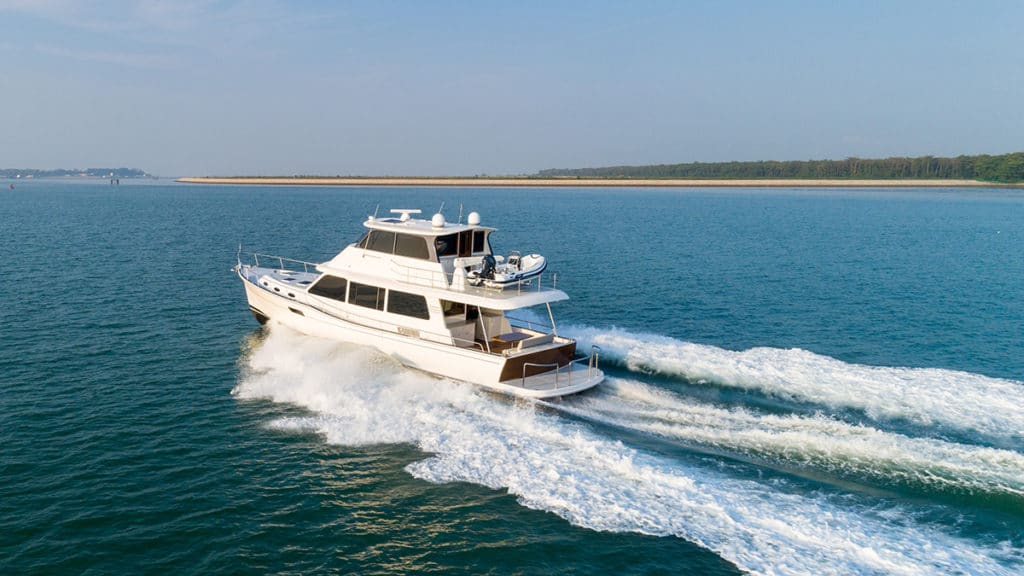
| 66’10” | |
| 19’2” | |
| 1,532 Gal. | |
| 291 Gal. | |
| 4’3” | |
| 62,832 lb. |
Krogen Express 52
The Krogen Express 52 runs on twin 440 hp Yanmar diesels and can cruise at 8 knots for 1,680 nautical miles or at 16 knots for 500 nautical miles. Top hop: 22 knots. In the interior, Krogen Express has outfitted the 52 with a master stateroom and a guest stateroom. The former has a queen island berth, more than 7-foot headroom, hanging lockers and smaller cubbies to port and to starboard, and an en suite head with a molded fiberglass shower stall with a seat, a VacuFlush toilet and a granite countertop. A power lift elevates the berth and grants access to more stowage underneath. The Krogen Express 52’s salon has a 26-inch HD LED TV and a home-theater system, leather Stressless chairs to port and a built-in, L-shape settee to starboard. The galley boasts granite countertops, a three-burner Force 10 propane range with an oven, a refrigerator, a GE microwave oven, a deep Elkay sink and a pullout sprayer faucet. There is a Buff Ultraleather Stidd helm seat for extra comfort during long runs.
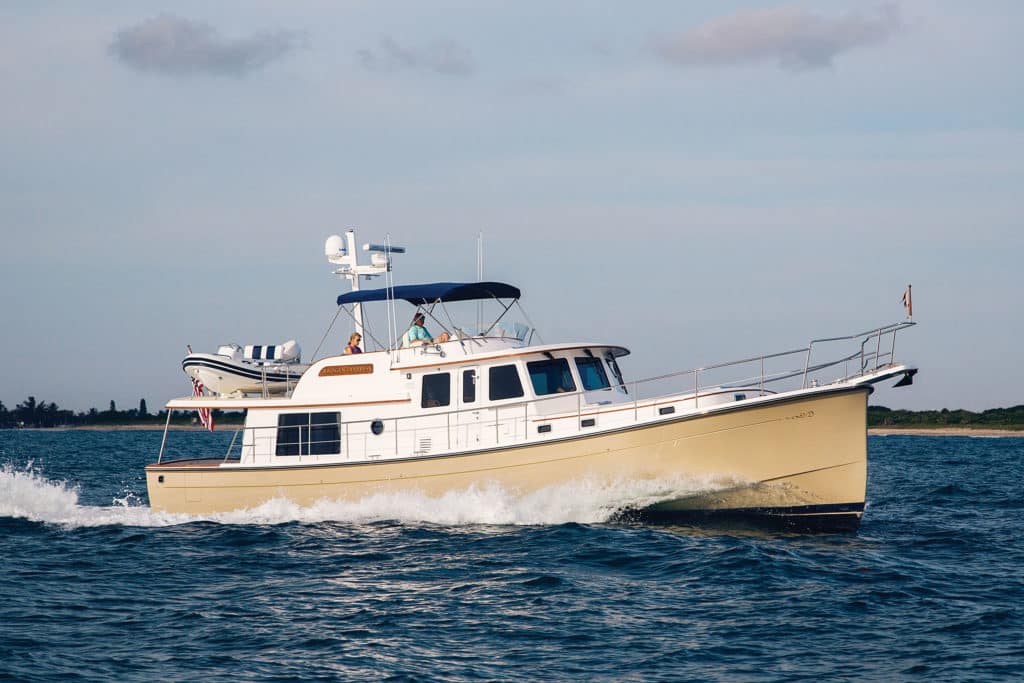
| 57’6” | |
| 15’11” | |
| 700 Gal. | |
| 370 Gal. | |
| 4’0” | |
| 43,000 lb. |
Grand Banks 85 Skylounge
The Grand Banks 85 Skylounge comes in at more than 87 feet length overall and displaces 108,000 pounds, with a 22-plus-foot beam and an air draft of just under 26 feet. Owners can choose either a three- or four-stateroom layout. The standard motors are twin 1,000 hp Volvo Penta IPS diesels, twin 1,300 hp MAN straight-shaft diesels are optional. With the larger engines, owners can also choose an optional stern thruster, in addition to the standard bow thruster. With the IPS diesels, top speed is 26.5 knots and fuel burn is 100 gallons per hour, resulting in a range of 699 nautical miles. At a 21-knot cruise speed, fuel consumption drops to 57 gph, and range climbs to 972 nm. At a 9-knot jog, fuel burn falls to 9 gph, and the Grand Banks 85 Skylounge can cruise nonstop for about 2,500 nautical miles.
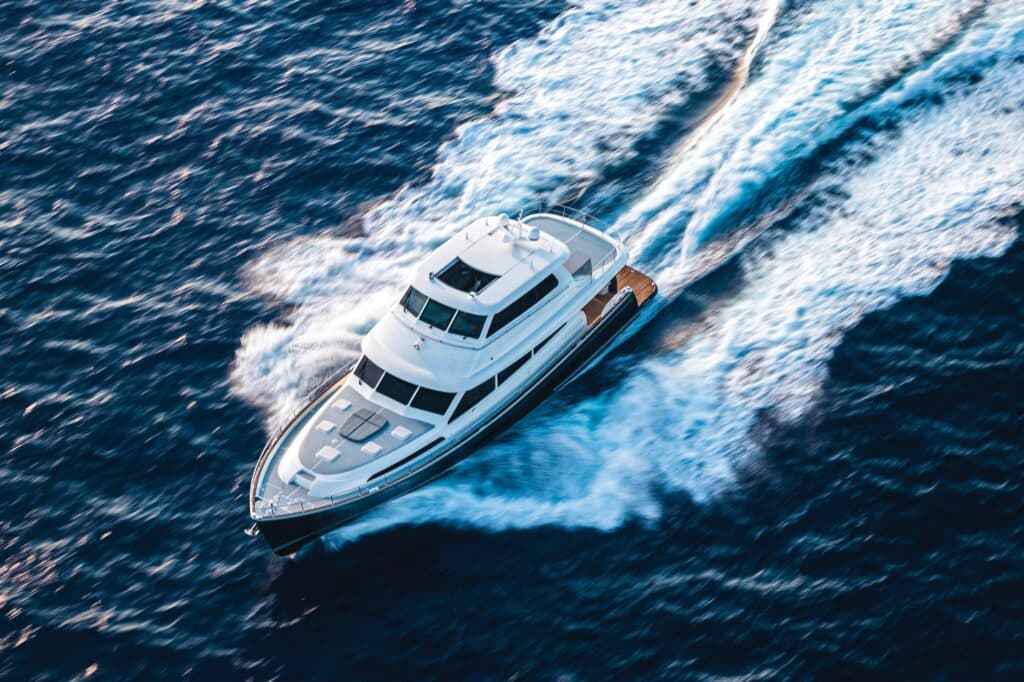
| 87’1” | |
| 22’2” | |
| 2,640 Gal. | |
| 370 Gal. | |
| 4’11” | |
| 108,025 lb. |
Vicem 82 Classic Flybridge
The Vicem 82 Classic is a flybridge model built in cold-molded mahogany, which creates a stout hull form with reduced weight. The yacht is notable for its timeless Downeast lines and strong joiner work. For cruising enthusiasts, the Classic 82 Flybridge is powered with twin 900 hp Volvo Penta D13 diesels . The yacht has a top-end speed of 17.8 knots, and the cruising speed is 15 knots. At 9 knots, and considering a 10-percent fuel reserve, range is reportedly 1,100 nautical miles. Accommodations three en-suite-equipped staterooms. The master stateroom is full-beam and amidships with a king-size berth is on centerline. The starboard-side guest stateroom and a forepeak VIP each have queen-size berths.
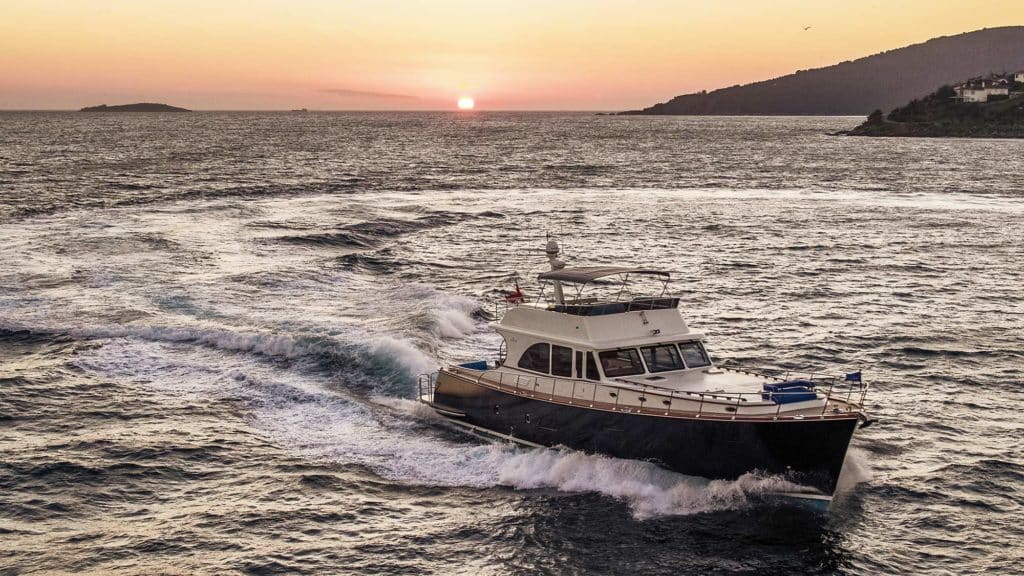
| 81’0” | |
| 20’4” | |
| 1,585 Gal. | |
| 500 Gal. | |
| 5’3” | |
| 10 Knots |
Outer Reef 610 Motoryacht
Built for an enthusiastic cruising couple after a three-year boat search, the Outer Reef Yachts 610 Motoryacht (part of the builder’s Classic series ), was customized with a fore-and-aft berth in the owners’ stateroom (as in, not athwartships), and berths rather than bunks in the smaller of two guest staterooms. This Outer Reef 610 was designed to be used as a liveaboard vessel, so the salon is not set up for dining (there are tables in the pilothouse, on the aft deck and on the bridge). A pair of swivel chairs in the salon face the built-in couch and the pop-up TV to port. The 610 is built with hand-laid fiberglass, PVC coring above the waterline, resin infusion and a vinylester barrier coat against osmosis. Power is twin 500 hp John Deere 6090 diesels turning ZF transmissions . The 610 tops out at about 13.5 knots with full tanks and 21 people aboard. The engines burn 20 gph at 1,800 rpm for 11 knots at 45 percent engine load. Those numbers should allow it to cross oceans without shortening engine life.
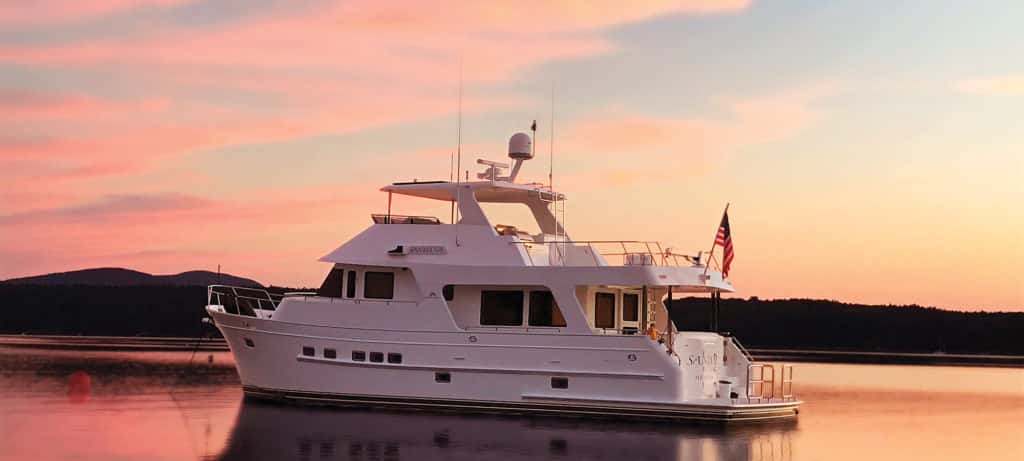
| 61’2” | |
| 17’2” | |
| 1,000 Gal. | |
| 300 Gal. | |
| 5’0” | |
| 93,000 lb. |
Nordhavn 59 Coastal Pilot
Nordhavn has long been known for its stout circumnavigation -capable craft, and the Nordhavn 59 Coastal Pilot carries on the the tradition of a beefy build with addition of…speed. Twenty-knots-plus, actually. Twin 715 hp Cummins diesel inboards and a new semidisplacement hull form are said to be key to the performance equation. The Nordhavn 59CP has a 777-nautical-mile range at a 9.3-knot cruise, and a 255-nm range at its 20.3-knot top-end. Construction is a solid fiberglass hull bottom supported by full-length longitudinal stringers and a series of transversal supports for added backbone. High freeboard should keep the decks dry in a seaway, while rails keep the crew secure during transits. Nordhavn says the 59CP has a “CE category A unlimited offshore rating, ensuring the vessel has the seakeeping and strength capabilities to take on most serious coastal cruises up to 1,000 miles.”
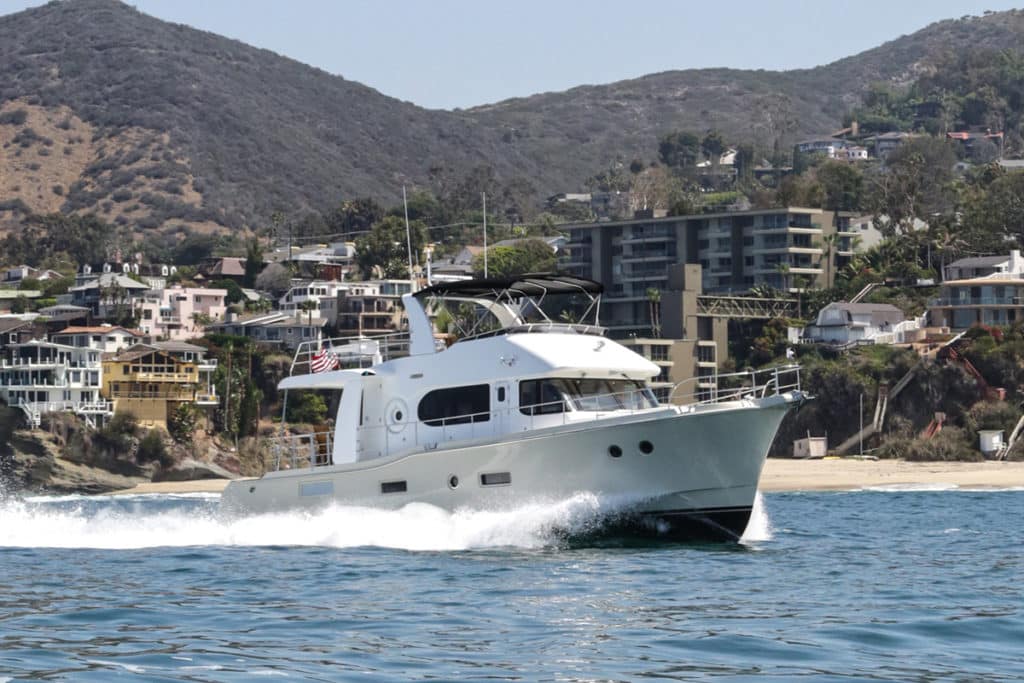
| 58’10” | |
| 17’0” | |
| 1,100 Gal. | |
| 444 Gal. | |
| 5’0” | |
| 88,000 lb. |
Marlow Yachts 58E
Following on the successful Marlow 57 , the Marlow 58E was started from scratch on a blank sheet of paper. The essence of the 58E is that it has better performance and more internal and external volume than her predecessor. The centerline length grew 10 inches over the 57, but the waterline length increased 16 inches and the beam widened 4 inches. If you were to examine the two boats out of the water, you would see more bell-shaped forward sections making for a soft impact with the vee’d portion. Power options start with twin 575 hp Caterpillar C9 diesels, but the 58E we got aboard had beefier twin 1,015 hp Caterpillar C18 diesels. Top speed: 27.9 knots. At 8 knots, the Marlow 58E can cruise nonstop for 1,400 nautical miles.
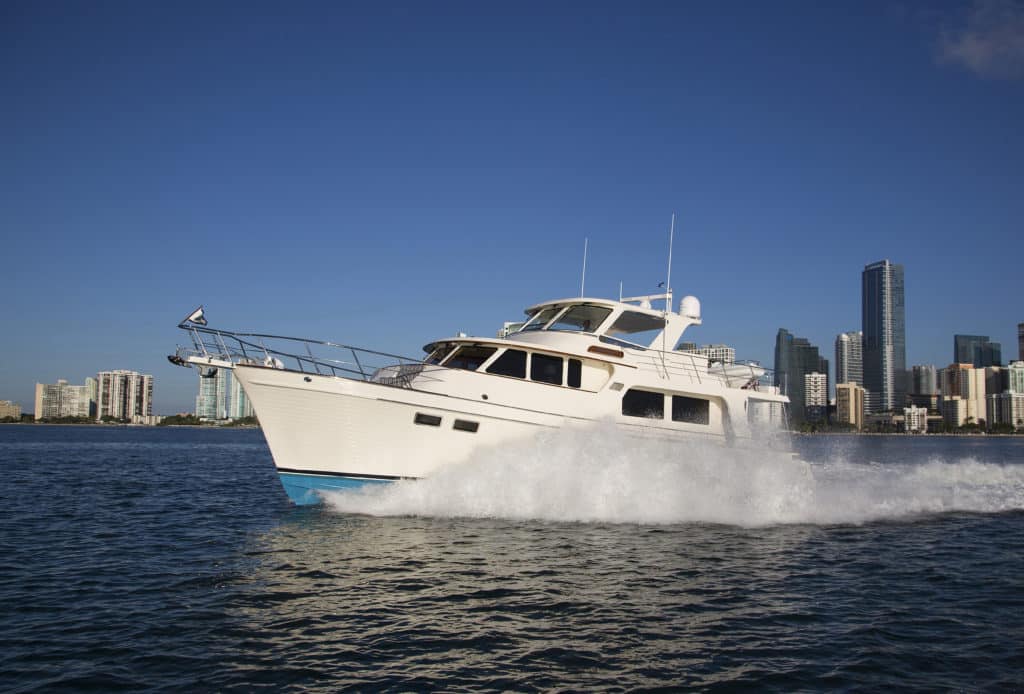
| 67’8” | |
| 18’6” | |
| 1,500 Gal. | |
| 300 Gal. | |
| 4’10” | |
| 69,000 lb. |
Frequently Asked Questions:
What is a trawler yacht?
A true trawler typically has a full-displacement hull form and robust construction to handle open-water operation, and it’s designed to operate self-sufficiently for long periods of time. They are slow-cruising vessels, but over the years, hybrid yachts called fast trawlers have emerged to offer displacement-speed operation as well as the ability to run at planing speeds when desired.
What is a full-displacement hull form?
A displacement-hull form is known is for its rounded nature and deep draft. Full-displacement vessels do not plane on the water, but rather push through the water. This hull design makes displacement-hull vessels incredibly seakindly, but it also makes them relatively slow (think 5, 6, 7, 8 knots) when compared to semidisplacement- and planning-hull designs.
Is a long-range cruiser the same as a trawler?
While all trawlers are certainly long-range cruisers, not all long-range cruisers are trawlers. True trawlers will have full-displacement hull designs and not all long-range cruisers have them.
- More: Beneteau , Bering Yachts , Grand Banks , Kadey-Krogen , Krogen Express , Marlow , Nordhavn , Outer Reef , Ranger Tugs , Trawlers , Vicem , Yachts
- More Yachts

Top Nine Fishing Tenders For 2024

First Look: Meet the Apreamare 88 Motoryacht Flagship

Holterman Shipyard Debuts Xtreme X-65

Unveiling the Tiara Yachts EX 54: A Comprehensive Review

Next-Level Cruising: 2022 Palm Beach PB70 For Sale

For Sale: 2014 Sabre 42 Salon Express

- Digital Edition
- Customer Service
- Privacy Policy
- Terms of Use
- Email Newsletters
- Cruising World
- Sailing World
- Salt Water Sportsman
- Sport Fishing
- Wakeboarding
Yachting Monthly
- Digital edition

The best sail plans for crossing an ocean
- Theo Stocker
- March 10, 2015
Sailing across an ocean, there are myriad sail plans and systems to choose from to power you across an ocean. We spoke to six ARC 2014 finishers to find out what works best

'Chance' round Pigeon Island Credit: Tim Wright
A warm wind at your back, the azure main rolling beneath your keel and unfettered miles left reeling in your wake. That’s the dream at least, but crossing an ocean isn’t always plain sailing, as the crews of the 2014 edition of the Atlantic Rally for Cruisers (ARC) discovered.
Those who took the rhumb line westwards from Gran Canaria to St Lucia in the Caribbean sailed hard and fast, and got wet as a result. Others sailed south for kinder but slower conditions. While some boats were sailing for glory, and others for comfort, or even just to arrive in one piece, they all proved that every Atlantic crossing is different and that preparation is the key to a successful passage.
After choosing a yacht and picking a crew, an Atlantic skipper must decide what sail plans to use and how to steer the boat. The range of options is huge. Sail-plans range from a simple main and genoa to more exotic coloured sails, and steering options span helming by hand, to windvane self-steering and electric autopilot systems.
Sails and steering interact and the two have to get along, so it’s never going to be a simple choice. The final decision may be based on many factors, but it’s only when land has slipped astern that these choices are really tested.
With the Atlantic behind them and the Caribbean sun overhead, we went to find out how the ARC crews got on.
10 tips from our Atlantic crews
- Learning to use ‘coloured sails’ offshore with confidence really pays off when running in light or moderate winds.

- Sail together beforehand. A long ocean passage can be really intense.
- Take lots of water, you’ll need it. If in doubt, take more.
- Take foul weather gear as it can be cold and wet. It is, after all, the North Atlantic in December.
- Know the noises your boat makes. A different sound is the first warning when something isn’t right.
- Food is important for morale. Seasoning and herbs go a long way. Little treats make a big difference.
- Clean out the fuel tank and take plenty of spare parts and filters as one isn’t enough, and know how to change them.
- A twin-grooved headsail foil gives more sail plan options than a single one.
- Satellite communications are a boon, but expect teething problems.
What is the best sail plan for ocean sailing?
The ‘best’ sail plans depends on your boat and crew, but our crews agreed on a few points:

- Twin headsails are simple, give a good amount of sail area and are easily furled. They lack power in lighter conditions and can make the boat roll. Two poles with guys and good sheeting angles are important.
- Coloured sails boost speed in certain conditions, but they require practice to build confidence. Mid-ocean, with large swells running, is not the time to try it for the first time. A symmetric spinnaker is best, but a cruising chute, wing-and-wing with the poled out genoa, is a good compromise. A Parasailor is significantly more stable than a conventional kite, but isn’t a panacea for all downwind sailing.

What is a Parasailor and how does it work?

Its makers claim it does three things:
- The gap allows air to flow over and through the sail, creating a steady airflow and making the sail more stable.
- The wing holds the width of the sail out and dampens the speed and force with which the sail can collapse.
- The wing creates lift, reducing the force pushing the bow down into the water, making the boat more directionally stable and less prone to roll.
Using a snuffer, it can be set from the bow, a pole, or flown loose like a kite. It’s not cheap, it’s still a spinnaker and needs some practice, but the manufacturer claims it puts the enjoyment back into downwind sailing.
The ARC 2014: facts and figures
ARC 2014 Routes
- Start Las Palmas, Gran Canaria
- Finish Rodney Bay, St Lucia
- Rhumb-line distance 2700 miles
- Fastest crossing Leopard by Finland (100ft Maxi), new record of 8 days, 14 hours, 39 minutes and 51 seconds.
- Average cruiser crossing 18 days, 11 hours
- Slowest crossing Efwa (Allegro 33), 25,days 13 hours, 34 minutes
- Shortest distance sailed Atalanta (Oyster 575) 2,690 miles
- Longest distance sailed Sanuk (Bavaria 47) 3,298 miles
- Average number of crew per boat in cruising division 5 adults
- Damage 22 boats suffered damage to sails, rigging or autopilots, mostly due to the forces of wind and waves on fully-laden boats
- Drop-outs 6 boats dropped out for medical or gear failure reasons
Enjoyed reading this?
A subscription to Yachting Monthly magazine costs around 40% less than the cover price .
Print and digital editions are available through Magazines Direct – where you can also find the latest deals .
YM is packed with information to help you get the most from your time on the water.
- Take your seamanship to the next level with tips, advice and skills from our experts
- Impartial in-depth reviews of the latest yachts and equipment
- Cruising guides to help you reach those dream destinations
Follow us on Facebook , Twitter and Instagram.

What kind of boats cross the Atlantic Ocean? 7 Options explained
You're looking for a way to go across the Atlantic without flying. What options are out there? Here are 7 options explained. I sailed five of them across the Atlantic.

Sailing an ocean on a Small sailing vessel
Many privately owned sailing vessels cross the Atlantic to spend a sunny sailing season either in the Mediterranean or Caribbean or as part of their around-the-world voyage. It is a big deal for them and attracts all sorts of seamen and women: young ‘pirate’ dudes who have escaped the rat race, adventure couples, retirees, families, groups of friends, and single older sailors.
The largest share of the captains is between 50 – 65 years old. It's the group that has the time and money resources to sail. All sorts of nationalities make the crossing, with the French and Swedish seeming to dominate the fleet.
By crewing on a small sailing yacht, you'll be involved with every aspect of seamanship and sailing. You will learn a lot for sure. Many boats choose to stop in Cape Verde or the Azores, and often don’t have tight schedules.

Boats come in all sorts of shapes and materials. Hulls are made from steel, wood, aluminium, and today mostly of fibreglass. 90% of the boats crossing the ocean is bigger than 36ft, with most of them measuring around 44ft. (14m).
A smaller yacht could also be perfectly ocean-worthy. I've seen boats of 26 ft. crossing the pond. Some adventure people row across the Atlantic. In 2017 someone even Stand Up Paddled (SUP) across the Atlantic. Being on any boat is a luxury compared to that.
Six people (out of 100) I interviewed in my book crossed the Atlantic on a boat smaller than 36ft. and all of them would like to do it again. This year we also have Nadiem, Ocean Nomads member who'll sail across in his little sailboat.
Both monohulls and catamarans cross the Atlantic. Catamarans are generally faster, more spacious, and rock less. On the flip side: they can flip! If they do, it’s a major challenge to come up again. Don’t worry, this is extremely unlikely. Having seen hundreds of boats planning, preparing and making the crossing, I estimate that roughly 70% of the boats that cross are monohulls.
With Ocean Nomads we sometimes have small liveaboard sailing vessels looking for crew in the network to sail across, or members recommend a vessel from their networks.
In our brand new Ocean Nomads Crew Course , I share all the tips and tricks for finding and securing a safe sailing vessel with which to sail as crew. Eco & Adventure style. Proper preperation makes all the difference for a happy, safe and meaningful voyage.
Sail with me & Ocean Nomads in Greece in 2024! Level up your sailing skills and make ocean people connections accelerating your sailing journey. 4 vessels, 11 days, 30 nomads! Learn More.
Sail across the Atlantic on Superyacht
Many larger yachts cross the Atlantic as a ‘delivery’, where a boat needs to be taken from point A to B. Boats have to be moved across the ocean for a new charter season, for the private owner who will hop on board again on the other side, or because someone bought it on the other continent.
Usually, paid and professional crew do these types of deliveries. As an amateur crew member, you can be a cheap extra set of hands.
A yacht is a ‘superyacht’ when it is over 24 metres (79ft.). These are big yachts. They often have generators running every day to keep fridges and freezers going. They load up thousands of litres of fuel and water, and are less dependent on the wind.
As such, there is less risk and generally more comfort. These trips often run on a tight schedule, so there won't be much flexibility for stops along the way (like in Cape Verde or the Azores). In most cases, there will also be more people on board (five-eight people compared to three-five on smaller vessels).
Crossing on a big boat like this is faster, less adventurous, and more comfortable. The crew are often younger, and some live and work permanently on the boat. Many of them have crossed the Atlantic Ocean numerous times and are therefore less excited about it than the average ‘yachtie'.
Timelines are tight and there’s often not time for island exploration. Usually, you are expected to work hard. Also, it's not unusual that superyachts don't even use the sails to prevent damaging, and have the sails tip /top for when the owner comes on board.
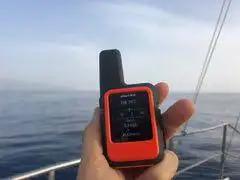
Garmin Inreach Mini2
A transatlantic on a charter yacht.
If you would rather not have the pre-crossing adventure or spend too much time searching for a boat, and/or if money is not an issue, you can book a charter ocean passage. Charter trips are organised on all sorts of boats: small, big, monohulls, catamaran, and racing boats.
Numerous racing yachts cross the ocean reaching boat speeds up to 35 knots! In addition to professional crew, spots are sold and you can sign up for a wet and speedy adventure guaranteed.
A charter trip costs between €2,000 and €10,000. An organized trip like this could be advantageous if you’re on a tight schedule. It’s more likely to leave on the planned date.
At the same time, the time schedule could be a disadvantage. What if the weather window is not ideal to leave? In many cases, though not always, everything is taken care of such as provisioning and cooking, so you wouldn’t have to figure out much yourself.
Charter organisations need to comply with a lot of safety requirements and check ups to legally carry out the voyage. This assures some safety but still you need to do your homework if it's a safe ride.
Another consideration of booking this type of passage is that you won’t know your shipmates. When you search the adventurous way, you have the opportunity to meet the other sailors before you commit to joining the crew. On a chartered passage you’re stuck with whoever else has booked the trip, even if you don’t like them.
With Ocean Nomads we work together with SV Twister and have the following Atlantic Crossings planned .
Sailing the Atlantic on a Tall ship
Every year, numerous tall ships sail across the Atlantic, like the Stad Amsterdam or Oosterschelde, and this year also SV Twister :) . Sailing across on a large traditional boat is spectacular. Many young people work on the tall ships. You could either try that or buy yourself a passage.
I wrote the above in my book, a friend of SV Twister reached out to me. Long story short, last year 2022/2023 I, with Ocean Nomads, organizing a trip across the Atlantic, Caribbean sea, and back across the Atlantic , and I now experience this way of sailing across also. You can join this trip in 2025 .

Update! We're back from the Atlantic. And we made a film about it:) Here is a the film about Sailing the Atlantic with Ocean Nomads. My 5th Atlantic crossing.
Travel the Ocean with a Sail Boat Ferry
There are no sailing ferries (yet), although boats are being built for this purpose. At the time of writing, Voyagevert is conducting feasibility studies to construct the fastest and largest sailing catamaran for a ferry service as a sustainable alternative to flight for transatlantic travel. Also Fair ferry is looking into it.
A transatlantic on a cruise ships
Another kind of ferry are the cruise ships. More and more cruise ships cross the Atlantic to do the season on the other side. They need relocation and spots on board are sold as ‘repositioning cruises.' It's often cheaper than airfare and your house rent combined. One option that is cool, is ‘ Nomadcruise ,’ an Atlantic crossing for entrepreneurs and digital nomads.
These floating cities are not an environmentally friendly way to cross. It takes around eight days and a lot of noise to cross with a cruise ship. Data on emissions is remarkably difficult to find. Some sources state that an average cruise ship at sea emits more, and less filtered, smoke than one million cars combined each day.
In a one-week trip, a large cruise ship generates ten backyard swimming pools of blackwater (raw sewage) and 40 more swimming pools of greywater (water from sinks, baths, showers, laundry, and galleys). It also generates large volumes of oily bilge water, sewage sludge, garbage, and noise.
Sail Across the Atlantic on a Cargo ship
More cargo ships cross the Atlantic than sailboats. This is a non-sailing ship option that can take you across. Cargo ships usually rent out a few cabins to passengers. This costs a few thousand euros. Travelling with a cargo vessel can be a good alternative if you want to cross the ocean, don’t like sailing, and do not want to fly. Prepare to be surrounded by engine noise. Crossing on a cargo would take one to two weeks. Depending on the weather, cargo and size, cargo vessels run between 15-25 knots .
There are also sailing cargo Atlantic crossing possibilities out there. ‘ Tres Hombres ‘ is a 32 metres Schooner transporting traditional goods like rum and chocolate between the Caribbean and Europe. Timbercoast is a 1920 built 43.5m Schooner that transports goods like coffee and gin. Both ships welcome crew on board helping out with this sustainable way of transporting goods.
My ocean sailing preference
“What kind of boat are you joining?” This was the first question most people asked me when I told them I was going to cross the Atlantic Ocean by sail. At the time, I knew nothing about boats, and thought “Does it matter? I just want to make the passage!” Having sailed across on five completely different boats across the Atlantic, I know now that the type of boat determines large part of the experience.Not just because of the boat, but because of the tasks and people involved with that type of boat.
My preference is to crew on a smaller monohull sailboat of 40-44ft – basic but adventurous and on these boats, I've met the coolest captains. Monohulls are more fun to sail. It's easier to ‘feel' the boat as opposed to a catamaran. It's kind of like a scooter versus a quadbike.
Smaller boats generally allow for more exploring and socialising time around the harbour- since there's usually less work to be done. This is the adventurous way of travelling by sailboat where you go with the weather and with others as excited about the adventure as you. I sailed as crew on these kind of sailboat for years ( Here is a video summary of my story ).
At the end, it's the people who make the trip! In my survey amongst 100 Atlantic ocean Crew & Captains who have done it, almost everyone answered to the question: “what would you do different, if you'd go again?” “I'd take more time to find the right vessel, with like minded and value sharing people.
Finding a boat is the easy part, finding the right and safe vessel aligned with your vibes and values, is the main challenge. With Ocean Nomads we now created a toolkit to help you dip your toes into the ocean nomads lifestyle , happy, safe, and meaningful.
How to find a sail boat ride across the Atlantic?
Here’s what I and ocean nomads have created for you to help you get out there, happy, safe, and meaningful.
It’s that time of the year again when many head south and west to follow the sun, catch the tradewinds, and realize ocean dreams.
Travelling an ocean on someone else’s sailing boat, or taking a stranger on board is not a straightforward endeavour. To be ready to expect the unexpected, careful investigation and preparation is essential. Four Ocean Crossings and 30.000 Miles of boat hitchhiking on dozens of vessels, as well as organizing crew for +10 different trips now, I figured out a few things, and keep learning:).
Here are the latest waypoints to help you on an ocean adventure, fun & impact:
- We’ve created resources and mini-courses on Sailing across the Atlantic, Offshore crew packing lists, Ocean crew preparing tips. Provisioning with minimum waste, Veggie recipes, Zero waste nomad life, and ocean education information. But the real value is the network you can tap into, find answers, connections, and support to make the ocean adventure dreams real.
- Because of that we can create way real value and attract real dedicated members only who are serious about making dreams real.
NEW in 2024! The Sailboat Travel Crew Prep course.
I help you transition from being new to sailboat travel to a confident crew member securing a position safe, soon and sustainable. All my sailing lifestyle crew tips condensed into one pack.

Ps. If any of the above has helped you, I'd love to hear so! Make a comment, leave a review on @oceanpreneur or @oceannomads.community, fill out the big Atlantic Ocean Crew survey
Related Posts

oceanpreneur
📍Hiking across the Pyrenees 🐕🏕️ GR11 🧜♀️ Travel with nature 🗺️+15yr Fulltime Adventurer by Sail & Van 🧭Sail with me & @oceannomads.community

On which boat have you crossed or would you be most exciting to cross the Atlantic?

Hi! My name is Suzanne. I'm here to excite and guide you into slow travel adventures, in tune with nature. 🗺️+15yr Fulltime Adventurer by Sail & Van 🧜♀️⛵️🚐✨🏕️
Adventure Videos
📍Hiking across the Pyrenees 🐕🏕️ GR11 🧜♀️ Travel with nature 🗺️+15yr Fulltime Adventurer by Sail & Van 🧭Sail with me & @oceannomads.community
- Understand what Rip Currents are, it’s dangers and how to stay safe with the sea
New Book on How to Travel by Sail as Crew
- How I prepare for my first solo long-distance hike with my dog | GR11 Trail La Transpirenaica
- Hiking and Camping in the Caribbean. Gear Essentials.
- Best Compost Toilets for Van Life, Campers and Sailboats | The Ultimate Guide 2024

Previous Post Tips on Foraging for Food. Journey to Self Sufficient Nomadlife
Next post why sail the ocean 12 reasons to jump on board an atlantic sailing adventure, you may also like.

The best appropriate boat is about 30 to 40 feet long. In case you using a smaller boat, there is a possibility that it may not withstand harsh weather conditions and ocean currents.
thank you so much for this cool article.
- Pingback: Keep Going In The Right Direction | Relationship Anatomy Inc
Leave a Reply Cancel Reply
Save my name, email, and website in this browser for the next time I comment.
subscribe to our newsletter
Sail With Me

© 2024 Oceanpreneur. Suzanne van der Veeken. Registration: KVK 60416947 VAT: NL001950161B95
- Canary Islands
- Saint Lucia
- Saint Vincent and the Grenadines
- Sail with me
- Crewing Tips
- Sail across the Atlantic Tips
- Sailing & Sustainability
- Sailing Opportunities
- Ocean Nomads Community
- Ocean Crew Course
- LONG DISTANCE HIKING
- Natural Living
- Ethical Travel
- Zero Waste & DIY
- Waterfiltration
- Conscious Gift Guide
- What can you do?
- Ocean Education
- Tips on Selfpublishing a Book
- What I read / listen
- Work with me
- Partners & Press

Can Yachts Cross The Pacific & Atlantic Oceans?
Both the Pacific and Atlantic oceans can be crossed in a yacht. You can cross the Pacific and Atlantic oceans on a sailing yacht or a motor yacht. It would be best to have a big enough tank to hold the amount of fuel you expect to burn.
This being said, not all yachts are capable of making these trips. If you decide to cross either of these oceans, you’ll want to make sure you have an ocean-faring yacht as well as the equipment and skills needed to make the trip.
Some yachts will not hold enough fuel to complete the trip and will typically be shipped on freighters designed for this.
In this post, I’ll go over some of the important facts you should know about yachts before you decide to make your voyage:
Table of Contents
Category “A” Yachts Are Ideal For Open Oceans
Yachts are categorized into four main categories.
These categories range from A to D, and they determine what type of waters the yacht was built to navigate.
Category “D” Yachts

A category D yacht is only rated for inland or sheltered coastal waters.
You can use them on lakes and rivers and even protected harbors.
They’ll do well as long as the waves don’t reach heights of over 4 feet.

Category “C” Yachts

A category C yacht is rated to be used inshore.
This means that it can head away from the protected harbors, but it shouldn’t go very far. Large bays and lakes can be navigated, and the boat can take on waves up to 8 feet high.
Category “B” Yachts

A category B yacht is designed to go offshore.
It can handle strong winds and waves of up to 13 feet.
While you probably wouldn’t want to do an ocean crossing in this vessel, it might be able to handle one of the weather stayed calm for an extended period of time.
One of the issues a category B would have is that it might not be built to be self-sustaining for the length of time needed to cross an ocean.
Also, it wouldn’t be able to hold up in the event of an extreme foul-weather event.
Category “A” Yachts

On the other hand, Category A boats are designed to sustain themselves for long voyages like a crossing of the world’s oceans.
They are made to withstand rough weather and storms so you won’t get lost in the middle of the Atlantic or Pacific.
They are longer than 40 feet and can take on waves of up to 23 feet. These boats can also take on strong winds of at least 47 knots.
They have weather systems and advanced computers that help you calculate and master the long trip of crossing the biggest seas.
Who Determines How A Yacht Is Categorized?
The manufacturer or boat builder will initially determine which category the boat should fall under.
However, this shouldn’t be the only determining factor.
To ensure that the yacht is actually built correctly for trips over the Atlantic and Pacific oceans, it should be certified by the International Marine Certification Institute.
When you’re looking to buy a yacht, make sure it has been rated by this institute. You can do this by looking for a certification plaque that will be mounted on the bulkhead.
Your Motor Yacht Should Be Able to Carry 1.5 Times The Amount of Fuel You’ll Need
Sailing yachts are often better suited for longer ocean crossings. One of the main reasons for this is that they can sail themselves for an indefinite amount of time.
This being said, you don’t have to own a sailing yacht to cross the Atlantic or the Pacific. A large motor yacht can potentially make the trip as well if it is designed for it.
How Much Fuel Is Needed To Cross The Atlantic & Pacific ocean?
For a medium-sized yacht, you should expect to have at least 500 gallons of fuel (2000 liters), unless you have sails.
If you are motoring in a big yacht, you will need more than that. You should bring 1.5 times the amount you expect to burn.
The motor yacht will need to be able to hold more than enough fuel for the trip, though.
This is because strong winds and currents can drastically increase the amount of fuel needed to complete a voyage. For this reason, many veteran sailors say that you should bring about 1.5 times the amount of fuel you think you’ll actually need to complete the voyage.
Remember, running out of fuel in the middle of the ocean is a whole lot different than running out of fuel while cruising up the coastline.
You may not see anyone for days in the ocean, and even if you do, they probably won’t be able to tow you back to shore.
Remember the boating flag rules if you travel abroad .
How Long Time Does It Take To Cross The Atlantic & Pacific Seas?

It will take around 20 days or more to cross the Atlantic ocean and potentially much more if you are using your sails instead of the motor.
Depending on the weather conditions, it can take significantly longer to cross the Pacific ocean with a large yacht with a strong motor.
These are very general numbers.
They will vary a lot according to how much fuel you are willing to burn. The faster your motor, the more fuel you will burn. You can also cross the oceans with a yacht with sails.
This will save fuel but be slower because of the boat’s characteristics and since you are much more dependent on the weather conditions.
You May Need to Upgrade Some of Your Systems
It takes a significant amount of time to make an ocean crossing.
During this time, you’ll need to meet your food, water, and energy requirements. You’ll also need to navigate the boat continuously.
Modern technology makes meeting these needs much easier.
In addition to having good navigation equipment, here are some systems you may want to consider upgrading to make life easier on the ocean.
- Your water maker.
- Your power generation systems.
- Your freezer.
- Your autopilot.
Water Makers
A watermaker will give you the ability to make your own potable water throughout your journey.
This cuts down on how much freshwater you need to pack and makes your yacht more self-sufficient.
This is important for a trip as long as crossing the Atlantic or Pacific sea.
Remember, your freshwater needs aren’t just restricted to drinking water. You’ll need fresh water for bathing, cooking, and for washing your yacht off as well. Most yachts will need daily cleanings as saltwater can quickly take its toll on a yacht’s decks and make the windows difficult to see through.
Power Generation Systems
A yacht can generate its own power using the sun, the wind, and the water.
They do this through the use of wind turbines, solar panels, and hydro-generators.
Wind turbines can create an impressive amount of energy in high winds. However, most people will want to travel downwind, which reduces the amount of power that the wind turbine can generate.
Solar panels work great on sunny days while the panels are angled towards the sun.
The drawback is that they do not work nearly as well when they’re shaded, and every day is not a sunny day while out on the water or land for that matter.
Hydro-generators, on the other hand, can generate power 24 hours a day. This is because the water’s movement powers them, and since you’ll be traveling day and night, you’ll always be generating energy.
The only drawback is that a hydro-generator does not produce a lot of energy at one time, and on sailboats, they will slow you down.
What Is The Best System to Use?
The best power generation system is a system that makes use of all of the technologies available.
Your energy requirements during an ocean crossing can be extremely high. Not only this but yachts, in general, tend to need more power than other vessels.
Add a hydro-generator, a wind turbine, and some solar panels to your system, and you’ll have power day and night whether your crossing wide-open expanses or anchor at one of the islands along the way. Larger sailing and power yachts also will typically have a diesel-powered generator or gen-set.
This one might be obvious, but you’ll need to pack a lot of food for your voyage.
Increasing the size and number of freezers you bring with you will increase the amount of meat and fruit you can bring.
Of course, you could skip this step and go with mostly dry foods instead. But honestly, what yacht owner wants to subsist on a daily diet of rice and beans?
Autopilot Systems

Your yacht will be moving at all times, and someone or something will need to be navigating it.
Autopilot systems make navigation easy and make an ocean crossing much less taxing.
Bring a backup autopilot system or spare parts for your existing system so that you can make any repairs necessary to keep it working throughout the entire trip.
Fail to do this, and you’ll find that the crew has to spend a lot more time navigating and a lot less time enjoying the journey.
Remember, it takes more than 20 days, at least, to cross the Atlantic ocean.
Your Crew Should Have Ocean Crossing Experience
It is possible to make an ocean crossing by yourself, but it isn’t recommended.
This is especially true if you’re making the crossing on a yacht.
The reason being, a yacht is going to be larger and more difficult to manage alone than a small sailing craft would be to manage alone.
For this reason, you’ll probably want to hire a crew or bring along plenty of friends or family members that can help you make the trip. At least one person on the crew should have some experience making an ocean crossing.
This person’s knowledge could prove invaluable both before and during the long trip. You and your other passengers should also have some experience with long passages so that you all know what to expect.
Trade Winds Will Dictate Your Voyage
You might think that you can easily shorten the time it takes to cross the Atlantic or Pacific oceans by making it a more direct one.
Unfortunately, this isn’t true, and your route will largely be dependent on trade winds.
What I mean by this is that you’ll end up traveling in a direction that follows the prevailing winds, so you are mostly traveling downwind. This reduces the stress on your boat, makes the ride more enjoyable, and even makes it quicker.
Final Thoughts
Many people have crossed the Atlantic and the Pacific oceans in yachts and many other types of watercraft.
Some experience and adequate preparations are important for a safe adventure.
If you’re planning on making the trip on your yacht, make sure you have the right boat for the job, the right crew for the journey, and the right technology to make everything simple and easy.
Click to share...

Crossing The Atlantic By Motor Yacht? Everything You Need To Know
A yacht can travel both the Pacific and Atlantic seas. A sailing boat or a motor yacht may span the Pacific and Atlantic seas. It’s preferable to have a tank large enough to store the amount of fuel you’ll be burning.
Not all yachts, however, are capable of undertaking these journeys. If you intend to sail across any of these seas, be sure you have an ocean-going boat as well as the necessary equipment and abilities.
Some yachts will not have enough fuel to make the journey and will be transported aboard specially constructed freighters.
In this essay, I’ll go over some of the key facts concerning yachts that you should be aware of before embarking on your journey.
How Long Does it Take to Sail Across the Atlantic?
Sailing across the Atlantic takes roughly 3-4 weeks, but if you’re lucky, use shortcuts, and have a speedy sailboat, you can accomplish it in two weeks. It might take up to a month if you don’t get enough wind for a week or longer. It’s critical to know the shortcuts, optimize speed, and have cross-Atlantic sailing expertise.
How Far Can a Yacht Travel?
In an 8-hour day, a powered boat of 35 feet in length can go over 200 miles at a speed of 25 knots. They can cover about 300 miles in a day at 35 knots. You can go thousands of kilometers if you have adequate gasoline or fill-ups.
Can a Yacht Cross the Atlantic Ocean?
A typical powered boat would require a tank with a capacity of roughly 5000 gallons of petrol and a fuel efficiency of 2.5 nautical miles per gallon to traverse the Atlantic.
This is based on a gasoline consumption rate of 4 gallons per hour at a cruising speed of 10 knots. Of course, this is at cruising speed. They can’t keep going at top speed for an extended amount of time (which would burn through the fuel faster).
The voyage (about 3,000 miles) would take 300 hours or 12.5 days at 10 knots.
Every year, sailing boats cross the Atlantic since the only fuel they use is to power generators that power aboard equipment.
When the weather isn’t cooperating, some fuel may be utilized to power the boat.A fast boat traveling at 25 knots takes roughly 4–5 days to cross the Atlantic Ocean. In a sailing yacht, though, it would take longer (which also depends on the winds).
We have a lot more information on which boat types are capable of crossing oceans. If you’re thinking of taking a boat journey across the oceans, this is a must-read.
Read more: Boat Fuel Tank Vent Open or Close (What to do?)
How Large Does A Boat Need To Be In Order To Cross The Atlantic Ocean?
To cross the Atlantic, you’ll need a boat that’s at least 30 feet long, whether you’re sailing or motoring. For safety and comfort, your boat should be at least 40 feet long. Although the experience of sailing or motoring across the Atlantic is vastly different, both require a boat of this size. If you plan on having a crew on board, you may need a boat that is much larger. Why do you need a 30 or 40 foot boat when you can cross the Atlantic with a lot smaller boat? The simple answer is that attempting to cross in anything smaller may be extremely risky and inconvenient. Here are a few reasons why you should get a boat at least this size:
Seaworthiness
You don’t want to be stranded in a tiny boat as the waves start to rise. In the Atlantic, boats significantly larger than 30 or 40 feet are often sunk due to bad weather.
If you go any smaller, you run the danger of being sunk in a storm. Make the mistake of assuming you can organize your vacation around the possibility of bad weather.
Storms may appear out of nowhere in the unpredictable Atlantic Ocean, and any vessel could be caught off guard, regardless of the season. Although not every 30 or 40-foot yacht is seaworthy enough to cross the North Atlantic, this size is a minimum need for ocean navigation.
Supply Storage
Even if you want to conduct as much open-ocean fishing as possible while crossing the Atlantic, you’ll need to have supplies. You should have enough food and drink for everyone in your crew to last the whole voyage.
Keep in mind that crossings can take longer than expected, so make sure you have adequate supplies to account for delays. You’ll need to reserve gasoline if you’re crossing in a motorboat or if you have a backup motor for your sailboat.
You may need a larger boat if you need to store a lot of provisions for your voyage. Too much weight can cause your boat to sink in the water, making even a seaworthy boat much less seaworthy. A boat that is too low in the water might be swamped by waves more quickly.
Before you load up your boat and set out on the water, be sure you know how much it can securely handle.
Comfort Of The Crew
Until you’ve spent a few weeks out on the open sea aboard a 30 or 40-foot boat, it may appear to be rather large. If you want to enjoy your passage, you’ll need a boat large enough for everyone on board to have their own space and stretch their legs at regular intervals throughout the journey. Even with a one- or two-person crew, 30 to 40 feet is required to achieve this aim.
Crossing The Atlantic In A Motorboat
You might be surprised to learn how much gasoline it takes to cross the Atlantic in a powerboat. Simply storing all of that fuel aboard your yacht can take up a lot of space.
Fuel should not be utilized for longer than 90 days in most cases. This should be enough time for you to cross the Atlantic, but it could not be. You may preserve fuel for up to six months or even two years if you use a fuel stabilizer or don’t mix it before use.
Fuel storage will require a large portion of your entire storage space. For the same journey, you could require a larger motorboat than a sailboat.
The advantage of crossing in a motorboat is that, while it may require more storage and gasoline, utilizing it instead of the wind for movement may make your route much more predictable. A speedboat can move in nearly any situation except particularly severe and inclement weather, but a sailboat must wait for the wind to be right to make headway. As a result, you won’t need as many resources to prepare in case you don’t arrive at your location on time.
Enjoy Your Crossing
It’s difficult to imagine a more thrilling experience than sailing the Atlantic Ocean on your own boat. You will most likely have a very pleasurable vacation whether what kind of boat you choose, as long as you choose a boat of at least 30 or 40 feet and plan wisely.
Leave a Comment Cancel reply
Save my name, email, and website in this browser for the next time I comment.

- OUR TRAWLER YACHTS
- – KROGEN 44 AE
- – KROGEN 48 AE
- – KROGEN 50 Open
- – KROGEN 52
- – KROGEN 58 EB
- – KROGEN 60 OPEN
- – KROGEN 70
- OUR PERFORMANCE YACHTS
- – SUMMIT MOTORYACHTS
- PRE-OWNED YACHTS
- Full Displacement Trawler Explained
- Kadey-Krogen Hull Design
- Bluewater Cruising
- Engines and Systems
- Construction
- Living On Our Trawlers
- Accommodations
- The Kadey-Krogen Team
- Trawler Living
- Atlantic Crossings
- Inside Passage
- Owner Groups and Blogs
- Latest News and Updates
- Waypoints Magazine
Crossing the Atlantic on a Yacht in Comfort
Experienced cruisers often discover Kadey-Krogen Yachts because they begin to search for yachts capable of crossing the Atlantic. If one searches the listings for Transatlantic boats for sale or contacts a broker with a very specific request to hear about yachts that can cross the Atlantic, they’re bound to discover plenty of superyachts, and some custom trawlers, and, of course, a selection of our models that are built to take on long bluewater cruising legs such as one takes on for an ocean crossinig.
Those who are more serious about open-ocean crossings begin to think about the best time to cross the Atlantic west to east and also consider provisioning, crew, a timetable, potential destinations, and all the factors, large and small, that enter into this exciting equation.

Lessons Learned in more than two years of cruising in Northern Europe

Journey from Rhode Island to Ireland Via the Azores

Home » Blog » Buy a boat » 5 best small sailboats for sailing around the world
5 best small sailboats for sailing around the world
By Author Fiona McGlynn
Posted on Last updated: April 19, 2023

A small sailboat can take you big places
Small sailboats are the ticket to going cruising NOW — not when you retire, save up enough money, or find the “perfect” bluewater cruising boat. In fact, it’s the first principle in Lin and Larry Pardey’s cruising philosophy: “Go small, go simple, go now.”
Small yachts can be affordable, simple, and seaworthy . However, you won’t see many of them in today’s cruising grounds. In three years and 13,000 nautical miles of bluewater cruising, I could count the number of under 30-foot sailboats I’ve seen on one hand (all of them were skippered by people in their 20s and 30s).
Today’s anchorages are full of 40, 50, and 60-foot-plus ocean sailboats, but that’s not to say you can’t sail the world in a small sailboat. Just look at Alessandro di Benedetto who in 2010 broke the record for the smallest boat to sail around the world non-stop in his 21-foot Mini 6.5 .
So long as you don’t mind forgoing a few comforts, you can sail around the world on a small budget .

What makes a good blue water sailboat
While you might not think a small sailboat is up to the task of going long distances, some of the best bluewater sailboats are under 40 feet.
However, if you’re thinking about buying a boat for offshore cruising, there are a few things to know about what makes a small boat offshore capable .
Smaller equals slower
Don’t expect to be sailing at high speeds in a pocket cruiser. Smaller displacement monohulls are always going to be slower than larger displacement monohulls (see the video below to learn why smaller boats are slower). Therefore a smaller cruiser is going to take longer on a given passage, making them more vulnerable to changes in weather.
A few feet can make a big difference over a week-long passage. On the last leg of our Pacific Ocean crossing, our 35-foot sailboat narrowly avoid a storm that our buddy boat, a 28-foot sailboat, couldn’t. Our friend was only a knot slower but it meant he had to heave to for a miserable three days.

Small but sturdy
If a pocket cruiser encounters bad weather, they will be less able to outrun or avoid it. For this reason, many of the blue water sailboats in this list are heavily built and designed to take a beating.
Yacht design has changed dramatically over the last 50 years. Today, new boats are designed to be light and fast. The small sailboats in our list are 30-plus year-old designs and were built in a time when weather forecasts were less accurate and harder to come by.
Back in the day, boat were constructed with thicker fiberglass hulls than you see in modern builds. Rigs, keels, rudders, hulls and decks – everything about these small cruising sailboats was designed to stand up to strong winds and big waves. Some of the boats in this post have skeg-hung rudders and most of them are full keel boats.
The pros and cons of pocket cruiser sailboats
Pocket cruiser sailboats present certain advantages and disadvantages.
More affordable
Their smaller size makes them affordable bluewater sailboats. You can often find great deals on pocket cruisers and sometimes you can even get them for free.
You’ll also save money on retrofits and repairs because small cruising sailboats need smaller boat parts (which cost a lot less) . For example, you can get away with smaller sails, ground tackle, winches, and lighter lines than on a bigger boat.
Moorage, haul-outs, and marine services are often billed by foot of boat length . A small sailboat makes traveling the world , far more affordable!
When something major breaks (like an engine) it will be less costly to repair or replace than it would be on a bigger boat.

Less time consuming
Smaller boats tend to have simpler systems which means you’ll spend less time fixing and paying to maintain those systems. For example, most small yachts don’t have showers, watermakers , hot water, and electric anchor windlasses.
On the flip side, you’ll spend more time collecting water (the low-tech way) . On a small sailboat, this means bucket baths, catching fresh water in your sails, and hand-bombing your anchor. Though less convenient, this simplicity can save you years of preparation and saving to go sailing.
Oh, and did I mention that you’ll become a complete water meiser? Conserving water aboard becomes pretty important when you have to blue-jug every drop of it from town back to your boat.
Easier to sail
Lastly, smaller boats can be physically easier to sail , just think of the difference between raising a sail on a 25-foot boat versus a 50-foot boat! You can more easily single-hand or short-hand a small sailboat. For that reason, some of the best solo blue water sailboats are quite petite.
As mentioned above small boats are slow boats and will arrive in port, sometimes days (and even weeks) behind their faster counterparts on long offshore crossings.
Consider this scenario: two boats crossed the Atlantic on a 4,000 nautical mile route. The small boat averaged four miles an hour, while the big boat averaged seven miles an hour. If both started at the same time, the small boat will have completed the crossing two weeks after the larger sailboat!
Less spacious
Living on a boat can be challenging — living on a small sailboat, even more so! Small cruising boats don’t provide much in the way of living space and creature comforts.
Not only will you have to downsize when you move onto a boat you’ll also have to get pretty creative when it comes to boat storage.
It also makes it more difficult to accommodate crew for long periods which means there are fewer people to share work and night shifts.
If you plan on sailing with your dog , it might put a small boat right out of the question (depending on the size of your four-legged crew member).

Less comfortable
It’s not just the living situation that is less comfortable, the sailing can be pretty uncomfortable too! Pocket cruisers tend to be a far less comfortable ride than larger boats as they are more easily tossed about in big ocean swell.
Here are our 5 favorite small blue water sailboats for sailing around the world
When we sailed across the Pacific these were some of the best small sailboats that we saw. Their owners loved them and we hope you will too!
The boats in this list are under 30 feet. If you’re looking for something slightly larger, you might want to check out our post on the best bluewater sailboats under 40 feet .
Note: Price ranges are based on SailboatListings.com and YachtWorld.com listings for Aug. 2018
Albin Vega 27($7-22K USD)

The Albin Vega has earned a reputation as a bluewater cruiser through adventurous sailors like Matt Rutherford, who in 2012 completed a 309-day solo nonstop circumnavigation of the Americas via Cape Horn and the Northwest Passage (see his story in the documentary Red Dot on the Ocean ).
- Hull Type: Long fin keel
- Hull Material: GRP (fibreglass)
- Length Overall:27′ 1″ / 8.25m
- Waterline Length:23′ 0″ / 7.01m
- Beam:8′ 1″ / 2.46m
- Draft:3′ 8″ / 1.12m
- Rig Type: Masthead sloop rig
- Displacement:5,070lb / 2,300kg
- Designer:Per Brohall
- Builder:Albin Marine AB (Swed.)
- Year First Built:1965
- Year Last Built:1979
- Number Built:3,450
Cape Dory 28 ($10-32K USD)

This small cruising sailboat is cute and classic as she is rugged and roomy. With at least one known circumnavigation and plenty of shorter bluewater voyages, the Cape Dory 28 has proven herself offshore capable.
- Hull Type: Full Keel
- Length Overall:28′ 09″ / 8.56m
- Waterline Length:22′ 50″ / 6.86m
- Beam:8’ 11” / 2.72m
- Draft:4’ 3” / 1.32m
- Rig Type:Masthead Sloop
- Displacement:9,300lb / 4,218kg
- Sail Area/Displacement Ratio:52
- Displacement/Length Ratio:49
- Designer: Carl Alberg
- Builder: Cape Dory Yachts (USA)
- Year First Built:1974
- Year Last Built:1988
- Number Built: 388
Dufour 29 ($7-23K)

As small bluewater sailboats go, the Dufour 29 is a lot of boat for your buck. We know of at least one that sailed across the Pacific last year. Designed as a cruiser racer she’s both fun to sail and adventure-ready. Like many Dufour sailboats from this era, she comes equipped with fiberglass molded wine bottle holders. Leave it to the French to think of everything!
- Hull Type: Fin with skeg-hung rudder
- Length Overall:29′ 4″ / 8.94m
- Waterline Length:25′ 1″ / 7.64m
- Beam:9′ 8″ / 2.95m
- Draft:5′ 3″ / 1.60m
- Displacement:7,250lb / 3,289kg
- Designer:Michael Dufour
- Builder:Dufour (France)
- Year First Built:1975
- Year Last Built:1984
Vancouver 28 ($15-34K)

A sensible small boat with a “go-anywhere” attitude, this pocket cruiser was designed with ocean sailors in mind. One of the best cruising sailboats under 40 feet, the Vancouver 28 is great sailing in a small package.
- Hull Type:Full keel with transom hung rudder
- Length Overall: 28′ 0″ / 8.53m
- Waterline Length:22’ 11” / 6.99m
- Beam:8’ 8” / 2.64m
- Draft:4’ 4” / 1.32m
- Rig Type: Cutter rig
- Displacement:8,960lb / 4,064 kg
- Designer: Robert B Harris
- Builder: Pheon Yachts Ltd. /Northshore Yachts Ltd.
- Year First Built:1986
- Last Year Built: 2007
- Number Built: 67
Westsail 28 ($30-35K)

Described in the 1975 marketing as “a hearty little cruiser”, the Westsail 28 was designed for those who were ready to embrace the cruising life. Perfect for a solo sailor or a cozy cruising couple!
- Hull Type: Full keel with transom hung rudder
- Hull Material:GRP (fibreglass)
- Length Overall:28′ 3” / 8.61m
- Waterline Length:23’ 6” / 7.16m
- Beam:9’ 7” / 2.92m
- Displacement:13,500lb / 6,124kg
- Designer: Herb David
- Builder: Westsail Corp. (USA)
- Number Built:78
Feeling inspired? Check out the “go small” philosophy of this 21-year-old who set sail in a CS 27.
Fiona McGlynn is an award-winning boating writer who created Waterborne as a place to learn about living aboard and traveling the world by sailboat. She has written for boating magazines including BoatUS, SAIL, Cruising World, and Good Old Boat. She’s also a contributing editor at Good Old Boat and BoatUS Magazine. In 2017, Fiona and her husband completed a 3-year, 13,000-mile voyage from Vancouver to Mexico to Australia on their 35-foot sailboat.
Saturday 1st of September 2018
Very useful list, but incomplete - as it would necessarily be, considering the number of seaworthy smaller boats that are around.
In particular, you missed/omitted the Westerly "Centaur" and its follow-on model, the "Griffon". 26 feet LOA, bilge-keelers, weighing something over 6000 pounds, usually fitted with a diesel inboard.
OK, these are British designs, and not that common in the US, but still they do exist, they're built like tanks, and it's rumored that at least one Centaur has circumnavigated.
Friday 31st of August 2018
This is a helpful list, thank you. I don't think most people would consider a 28' boat a pocket cruiser, though!
Terms and Conditions - Privacy Policy
Boat Pursuits
Can yachts cross the ocean heres what you need to know.

Crossing an ocean in a yacht is an incredible experience, but it is also an undertaking that requires a great deal of preparation.
To successfully cross an ocean in a yacht, you must be familiar with the different types of yachts, assess the yacht’s seaworthiness, understand navigational capabilities, properly provision for the voyage, consider crew requirements, and be aware of the challenges and rewards of crossing the ocean.
In this article, you’ll learn all of the essential information you need to know about crossing the ocean in a yacht.
Get ready to set sail and explore the boundless beauty and adventure of the open sea!.
Table of Contents
Short Answer
Yes, yachts can cross the ocean.
They are typically equipped with long-range fuel tanks and navigation systems that allow them to make long journeys over open water.
Additionally, many yachts are equipped with modern technology such as GPS and satellite communication, which can help to ensure safety during long ocean crossings.
Some yachts even have fully-enclosed cabins and amenities such as air conditioning and refrigeration, making them well-suited for extended trips.
Types of Yachts
Yachts come in a variety of sizes and styles, ranging from small day-sailing boats to large luxury cruisers.
The type of yacht you choose for an ocean crossing needs to be suited to the journey and its conditions.
Generally, larger yachts are better suited for long-distance ocean trips due to their greater stability, more comfortable accommodations, and better navigation and safety features.
Sail-powered yachts can be further divided into two main categories: monohulls and multihulls.
Monohulls are traditional single-hulled vessels, while multihulls have two or more hulls connected by a platform.
Multihulls tend to be faster but less stable than monohulls, so they may not be the best choice for longer voyages.
Additionally, many modern yachts are motorized, offering more speed and range than sail-powered vessels.
Motorized yachts are typically better suited for short-distance cruising, though some are equipped for long-distance voyages.
Assessing the Yacht’s Seaworthiness

When assessing the seaworthiness of a yacht for ocean crossings, a thorough inspection is essential.
This should include a review of the vessels hull, keel, rudder, and rigging to ensure they are in good condition and can withstand the rigors of an extended voyage.
The yachts navigational systems should also be checked to make sure they are in good working order and able to accurately chart a course across the ocean.
Its important to consider the yachts fuel capacity and range, as well as the availability of spare parts for any needed repairs.
Additionally, the yacht should be outfitted with the necessary safety gear, such as life rafts, flares, and fire extinguishers.
Finally, the yacht should have adequate ventilation, good insulation, and comfortable sleeping quarters for all crew members.
With these considerations in mind, a yacht can safely and confidently embark on an ocean crossing.
Navigational Capabilities
When it comes to crossing an ocean in a yacht, having the right navigational capabilities is essential.
Yachts must be equipped with the latest and most reliable navigational instruments and charts to ensure a safe and successful voyage.
A good navigator will be knowledgeable of the local waters and prevailing weather and ocean conditions and be able to accurately plot a course.
They should be familiar with satellite navigation and communication systems, global positioning systems (GPS), and other navigational aids such as radar and automated identification systems (AIS).
Additionally, they should be adept at dead reckoning, compass navigation, and celestial navigation.
If possible, the navigator should have prior experience with crossing the ocean in a yacht, as this will give them a better understanding of the potential risks and hazards.
Provisioning for the Voyage

When crossing an ocean in a yacht, it is essential to properly provision the vessel for the voyage.
This includes stocking the yacht with enough food, water, fuel, and other supplies to last for the entire journey.
It is important to research the expected length of the voyage and the expected weather conditions to ensure the yacht is adequately prepared for any potential hardships that may arise.
Additionally, extra supplies such as spare parts, navigational tools, and emergency equipment should be on board in case of any unforeseen issues.
It is also important to consider the number of people on board, as this will impact the amount of food, water, and other supplies needed.
Planning ahead and being prepared is key to a successful ocean voyage aboard a yacht.
Crew Requirements
Crossing an ocean in a yacht is an exciting experience, but it requires an experienced and knowledgeable crew.
The captain should have a deep understanding of navigation, seamanship, and maritime safety.
In addition, the crew should have a variety of skills to handle different tasks on board, such as sail handling, engine maintenance, and cooking.
It’s also important for the crew to be physically fit and able to work long hours in difficult conditions.
Depending on the size of the yacht, a minimum of two to four crew members is required to safely sail across an ocean.
It’s also beneficial to have crew members with experience in ocean sailing and knowledge of the vessel’s systems.
The crew should also be prepared to handle any unexpected scenarios that may arise on the voyage.
The Challenges of Crossing an Ocean

Crossing an ocean in a yacht is an impressive feat and requires careful preparation and navigation.
The yacht must be inspected to ensure it is seaworthy, capable of withstanding the long voyage and any potential storms or rough seas.
It must be adequately provisioned with food, water, and supplies, and the crew must be experienced and knowledgeable.
Cruisers must also be aware of potential safety risks, including piracy, collisions, and the threat of running aground.
Additionally, the yacht must be equipped with the necessary navigational equipment and the crew must be familiar with the route to take.
All of these factors can make crossing an ocean in a yacht a difficult and challenging task.
The Rewards of an Ocean Voyage
The rewards of an ocean voyage aboard a yacht are unparalleled.
For those seeking an adventure of a lifetime, crossing an ocean in a yacht offers an opportunity to explore the world in a way that few other activities can rival.
The sheer size of the ocean provides an immense sense of freedom, allowing travelers to feel the wind in their sails and the sun on their skin as they journey across the vast expanse of the sea.
Not only does crossing an ocean provide a unique adventure, but it also gives travelers a chance to observe the beauty of the natural world in a way that simply cant be replicated on land.
From the mesmerizing sights of sunsets and sunrises to the vastness of the night sky, the ocean provides a stunning backdrop for exploration.
In addition to the physical rewards, traveling by yacht across an ocean can also be extremely rewarding on a psychological level.
As travelers journey across the sea, they will be faced with challenges that will test their resilience and resourcefulness.
This can be a great opportunity to learn more about oneself, as well as to gain a better understanding of the world around us.
The experience of crossing an ocean can also be incredibly calming and therapeutic, as travelers can take time to disconnect from the daily hustle and bustle of life and simply enjoy the journey.
Finally, crossing an ocean by yacht offers a unique opportunity to bond with the people who are traveling with you.
As you all work together to overcome the obstacles that arise, youll find that the bonds of friendship and camaraderie become even stronger.
The experience of crossing an ocean is truly a special one, and it is something that will be remembered and cherished for years to come.
Final Thoughts
Crossing an ocean in a yacht is an incredible, rewarding experience.
Whether youre looking to circumnavigate the globe or just enjoy a leisurely ocean voyage, there is much to consider when preparing for a successful journey.
From assessing the yacht’s seaworthiness and navigational capabilities to provisioning for the voyage and selecting an experienced and knowledgeable crew, the challenges are many.
But with the right preparation, you can make your ocean-crossing dreams come true.
So what are you waiting for? Go out and explore the world!.
James Frami
At the age of 15, he and four other friends from his neighborhood constructed their first boat. He has been sailing for almost 30 years and has a wealth of knowledge that he wants to share with others.
Recent Posts
When Was Banana Boat Song Released? (HISTORICAL INSIGHTS)
The "Banana Boat Song" was released in 1956 by Harry Belafonte. This calypso-style song, also known as "Day-O," became a huge hit and remains popular to this day for its catchy tune and upbeat...
How to Make Banana Boat Smoothie King? (DELICIOUS RECIPE REVEALED)
To make a Banana Boat Smoothie King smoothie at home, start by gathering the ingredients: a ripe banana, peanut butter, chocolate protein powder, almond milk, and ice. Blend the banana, a scoop of...
Yachting World
- Digital Edition

The best route for an Atlantic crossing? It depends when you go
- Belinda Bird
- May 29, 2015
Sailor and meteorologist Chris Tibbs advises go south for comfort and safety; go north for speed
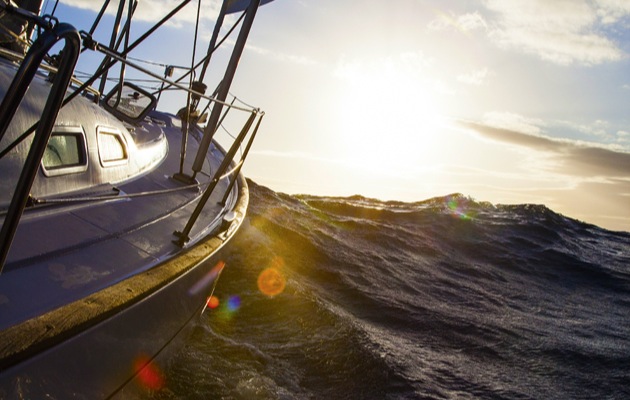
Weather is a large part of any Atlantic crossing: deciding when to go, which route to follow and the sails to carry. The main consideration is to avoid the hurricane season from June to November, so most yachts leave in late November to arrive in time for Christmas, although the tradewinds in January are often stronger.
However, it is human nature to push boundaries and some crews always leave early to get a longer season. The earlier you leave, though, the more important it is to stay east before committing to a westerly course. Late hurricanes generally develop to the west, making a passage via the Cape Verde islands more attractive. It shortens the time in potential hurricane areas and offers an escape route south as hurricanes rarely track south of 10°N.
Flexible sailplan
During a typical crossing, the tradewinds will be Force 4 or 5, with some lighter periods and a few days of winds of 25-plus knots. A flexible sailplan is necessary to take account of the changing wind strengths – there is no one-size-fits-all answer. The most common sailplan is goosewinged, with most skippers carrying a specialist downwind sail for when the wind goes light.

Because squalls are common and can have gale-force gusts on the leading edge, it is important to be able to reduce sail quickly. Boats with only asymmetric spinnakers tend to struggle in strong downwind conditions and I would always carry a whisker pole to pole out a headsail as well.
Sailing hot angles may work for a lightweight flyer, but it adds a lot of distance. For a heavier cruising boat it is hard to gain the increase in speed to compensate for the extra distance. Once hull speed is reached, shorter will always be faster. ( See our feature on the best yacht for an Atlantic crossing )
North is fastest
With well-established high pressure, a direct (that is, northerly) route is usually fastest, staying far enough away from the high to keep the wind, but minimising distance. However, the less established the high is, the greater the chance of a mid-Atlantic trough or low developing, giving adverse winds. In this case a more southerly route is better.
Racing boats often take the northerly route and the faster the boat, the more likely this will pay off. However, it runs the risk of meeting depressions which develop mid-Atlantic.
These should not be underestimated and the potential gain of passing north of a depression must be balanced against the risk that it could deepen and track across the route. The route is also more prone to a northerly swell.
The southerly route, on the other hand, offers lower risk, with steadier tradewinds and less chance of an uncomfortable northerly swell.
When does the engine go on?
I like to arrive with at least one-third of my fuel left for safety. Others will put on the engine when the wind drops and call in at Cape Verde to refuel if necessary. The choice of route may also depend on fuel capacity and a crew’s willingness to use the engine.
A mid-Atlantic trough giving 24-48 hours of light wind is not unusual and can be motored through to keep on schedule. Yet for some crews, the engine is only for emergencies and a more southerly route will reduce the risk of light winds. Neither route is right or wrong. They are just different ways of sailing in what may be very different boats.
I have sailed across the Atlantic over 20 times and no two times have been the same. There can be a great deal of variation and weather forecasts are important. There needs to be some flexibility in the route to take account of forecasts and how they change over time. I like to pick up weather charts from NOAA and also GRIB files.
So, the default options are: go south for comfort and safety; go north for speed. Most boats take a more middle route, depending on the forecast.

Chris Tibbs is a meteorologist and sailor with over 250,000 miles at sea, including three circumnavigations and six speed records. He is a lecturer to ARC crews and provides routeing services.
See also: 15 things you need to know when planning an Atlantic crossing
This is an extract from a feature in the November 2014 issue of Yachting World
If you enjoyed this….
Yachting World is the foremost international magazine for bluewater cruisers and offshore sailors. Every month we have practical features to help you plan and prepare to realise your sailing dreams. Build your knowledge month by month with a subscription delivered to your door – and at a discount to the cover price. S ee our latest offers now.

IMAGES
VIDEO
COMMENTS
The Atlantic Ocean, for example, is a journey of 3,000 nautical miles, so you'll want to ensure the yacht you are using to cross it is a sturdy, ocean going vessel. Many superyachts will make the Atlantic Ocean crossing twice a year - in the fall to head to the Caribbean, and in the spring to return to the Mediterranean.
Can Yachts Cross the Ocean
Last year, when we carried out our annual survey of ARC skippers, we found that yachts of between 46ft and 55ft had a battery capacity, on average, of 700ah, rising to 1,000ah for yachts over 56ft ...
New and Used Ocean Going Motor Yachts for Sale
Above: A 2022 Silent 62 triple deck catamaran yacht for sale on YachtWorld by Silent Yachts. Photo by Silent Yachts. This beautiful trans-ocean yacht is the ultimate in both luxury and design. With fully solar powered electric motors, it has an unlimited range, zero emission, and noiseless cruising. Multiple layout options offer 4-6 cabins ...
Best bluewater cruisers of 2022. The new flagship Allures 51.9, for example, is a no-nonsense adventure cruising design built and finished to a high standard. It retains Allures' niche of using ...
The best yachts for a transatlantic crossing. Neel 51. Outremer 5X. Hallberg-Rassy 57. There are many yachts which are suitable for a transatlantic passage. Some will be less expensive, some will be more comfortable, faster, or better suited to you, your experience, and your budget.
Top 15 Trawlers for 2023
The size of yacht needed to safely and comfortably cross the Atlantic Ocean will depend on factors such as the number of people on board, the type of voyage, and the experience of the captain and crew. Generally, the vessel should be a minimum of 36 feet in length and have enough stowage capacity to carry enough supplies and provisions for the ...
43 of the best bluewater sailboat designs of all time
Average cruiser crossing 18 days, 11 hours. Slowest crossing Efwa (Allegro 33), 25,days 13 hours, 34 minutes. Shortest distance sailed Atalanta (Oyster 575) 2,690 miles. Longest distance sailed Sanuk (Bavaria 47) 3,298 miles. Average number of crew per boat in cruising division 5 adults.
What kind of boats cross the Atlantic Ocean? 7 Options ...
Twelve Top Bluewater Cruising Boats
A category B yacht is designed to go offshore. It can handle strong winds and waves of up to 13 feet. While you probably wouldn't want to do an ocean crossing in this vessel, it might be able to handle one of the weather stayed calm for an extended period of time.
When the weather isn't cooperating, some fuel may be utilized to power the boat.A fast boat traveling at 25 knots takes roughly 4-5 days to cross the Atlantic Ocean. In a sailing yacht, though, it would take longer (which also depends on the winds). We have a lot more information on which boat types are capable of crossing oceans.
Crossing the Atlantic Ocean on a Trawler Yacht
Sailing across the Atlantic in the tradewinds - or back to Europe - is one of the biggest feats and adventures in sailing. In most cases, the crossing is the culmination of years of planning ...
Vancouver 28. Photo credit: YachtFathom.co.uk. A sensible small boat with a "go-anywhere" attitude, this pocket cruiser was designed with ocean sailors in mind. One of the best cruising sailboats under 40 feet, the Vancouver 28 is great sailing in a small package. Hull Type:Full keel with transom hung rudder.
Ocean Yachts for sale
Crossing an ocean in a yacht is an incredible experience, but it is also an undertaking that requires a great deal of preparation. To successfully cross an ocean in a yacht, you must be familiar with the different types of yachts, assess the yacht's seaworthiness, understand navigational capabilities, properly provision for the voyage, consider crew requirements, and be aware of the ...
On board, family ocean crossings at an average of 10 knots are the norm. Best bluewater multihulls for family cruising ... Garcia Yachts has cornered the market for series-built aluminium ...
What Size Boat For Ocean Crossing? If you're looking for a quick answer to this question, the Atlantic Rally For Cruisers (ARC), which is run by the World Cruising Club every year in November from the Canary Islands to the Caribbean, requires a length of 27 feet minimum sailboat sizes for ocean crossing, in order to enter the competition.
Most boats take a more middle route, depending on the forecast. Chris Tibbs is a meteorologist and sailor with over 250,000 miles at sea, including three circumnavigations and six speed records.